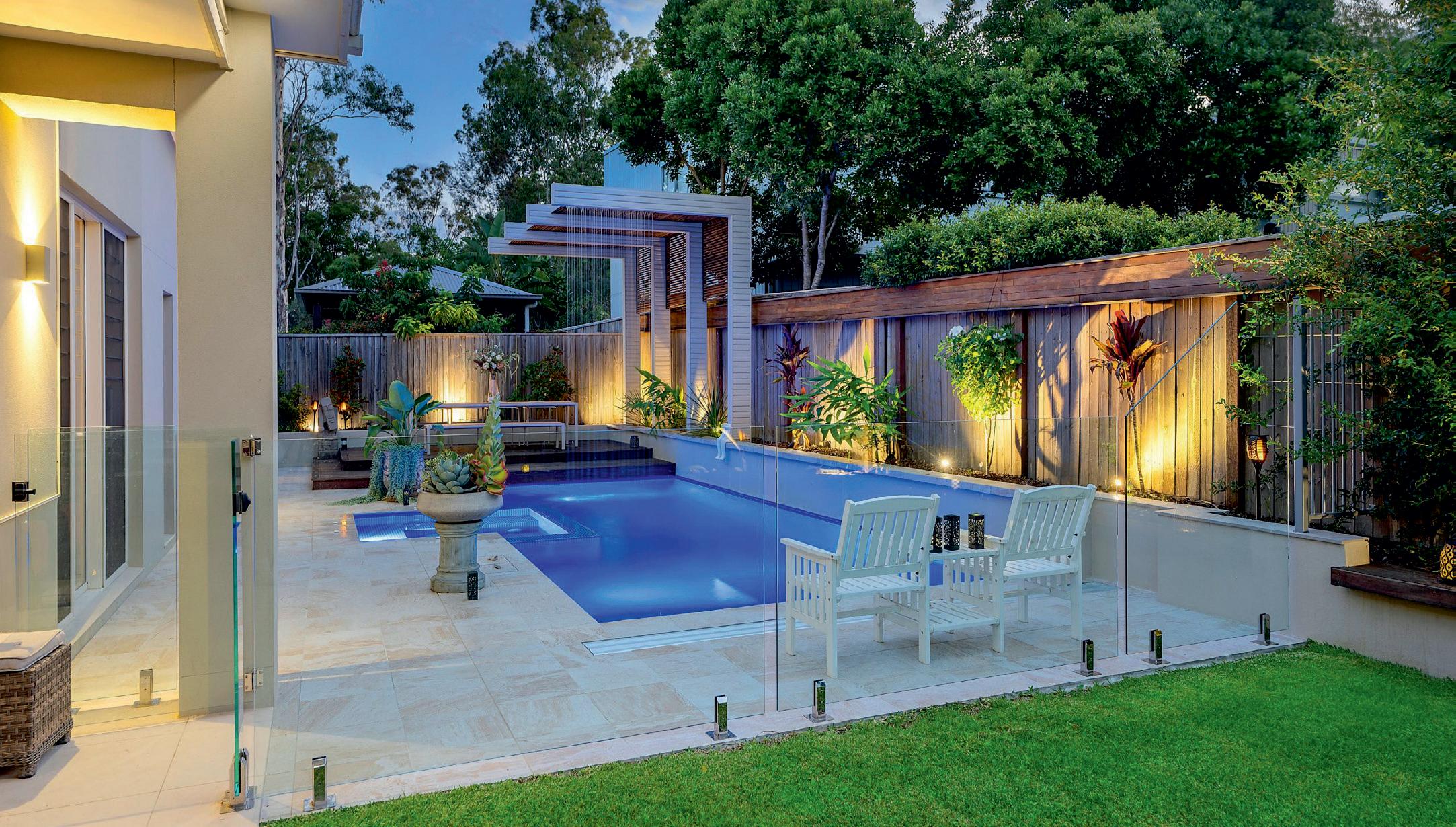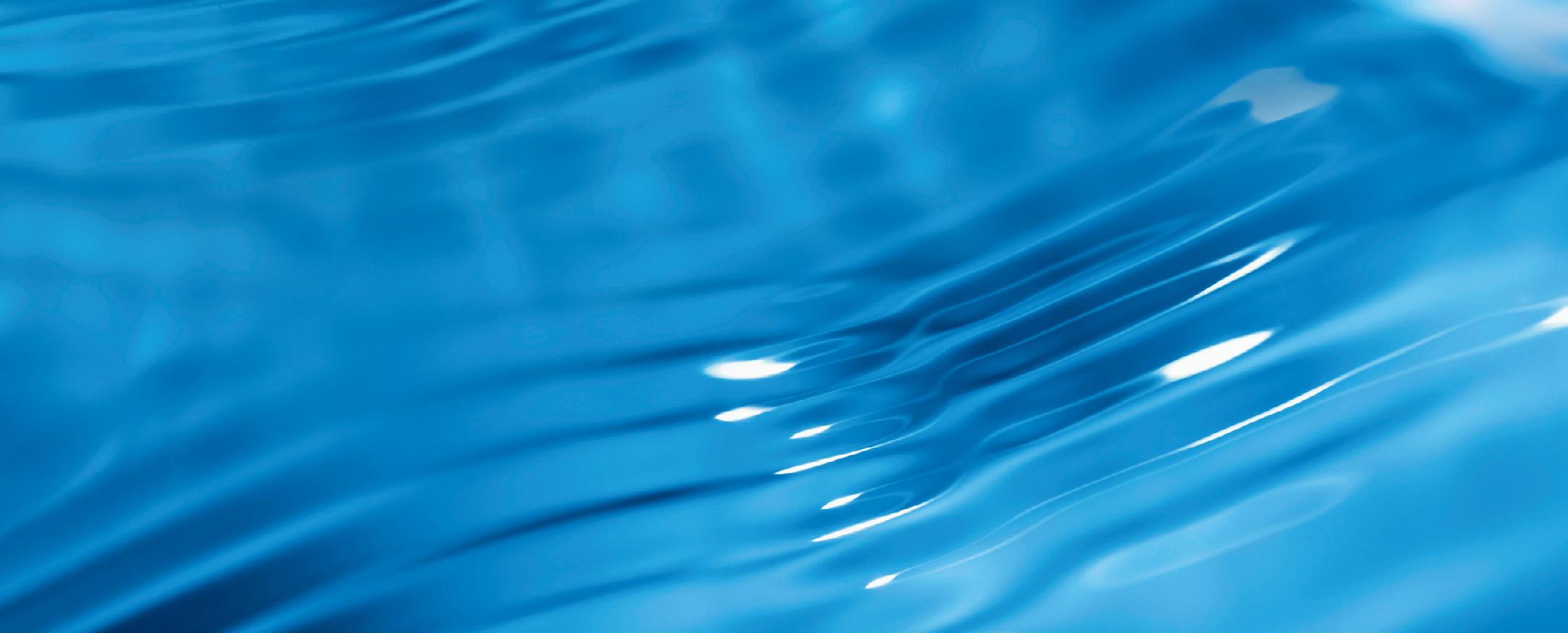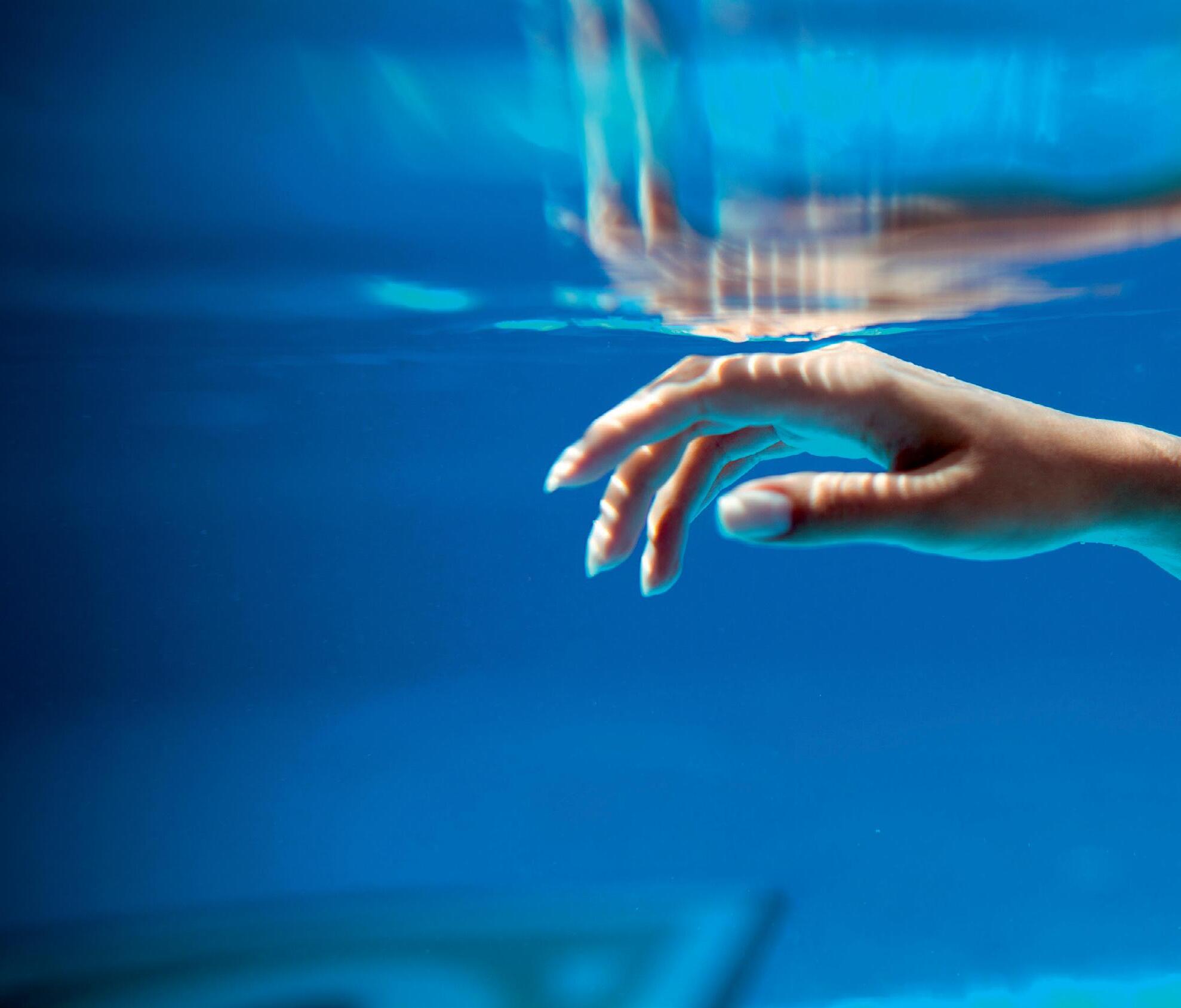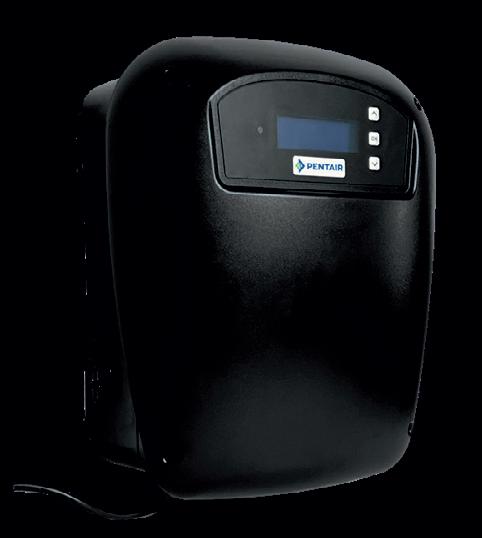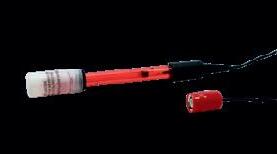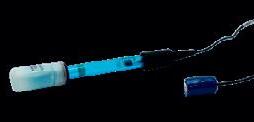POOL SPA &
Tricks,
Running on empty
DO YOU KNOW WHAT IT COSTS TO RUN YOUR POOL?




































DO YOU KNOW WHAT IT COSTS TO RUN YOUR POOL?



































Welcome to the first issue of Pool & Spa Enhancing Outdoor Living magazine for 2023.
As we head into autumn, spare a thought for our Kiwi readers, along with those in Queensland and the Top End of Australia. New Zealand’s North Island has suffered catastrophic weather conditions — including heavy rainfall, flash flooding and multiple cyclones — since summer began, following from a similar pattern in 2022. While parts of Australia enjoyed a mild and dry summer — the first after years of fires, floods and pandemic restrictions — the north, in particular, has been suffering a deluge in recent weeks. Hopefully we’ve seen the back of La Niña for a while and 2023 brings calm to Aotearoa and to Oz... along with a welcome return to less eventful times.
Meanwhile, March spells the beginning of the end for the swim season for many of us, so it’s time to start planning for the cooler months, whether that means maintenance, mothballing or a full-blown renovation.
If the turning season has got you thinking about a new look or design changes, have a read of our articles on pool decks and water features — they’re sure to give you enough ideas to kickstart your next project.
A long hot summer can wreak havoc on hair and skin health. If it feels like yours is screaming for some TLC, we’ve got all the tips to set things back to smooth.
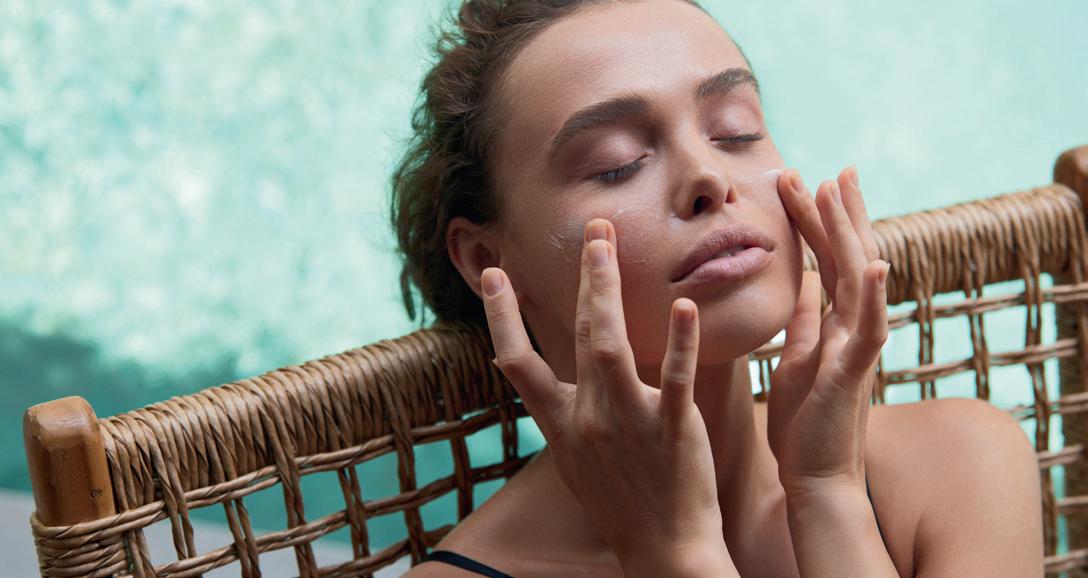
Ever wondered what it really costs to run your pool? Well, wonder no more. We break down the major running costs and give you ideas designed to help you save.
We hope you enjoy this issue of the magazine and find it full of useful info. Feel free to drop as a line with your thoughts, comments, questions and ideas at hello@poolspalife.com.au.
Happy swimming!
Q: I really enjoyed our swimming pool through my first two (summer) pregnancies. Now baby number three is on the way and will arrive in winter. Is it safe for me to use our spa?
A:This is a common question from mums-to-be. A long hot soak might seem like just the ticket when your bump starts to grow and your back starts to ache, but you really need to know a few things first.
Your doctor or other healthcare professional should be your first port of call for specific advice based on your exact circumstances and it’s likely the advice will vary for each stage. For example, there is a general recommendation to keep your body temperature below 39°C in the first trimester, so you should either lower the water temp or give the spa a miss for the first couple of months. Your doctor can give you further information.
Cleanliness and water balance is important, so regular monitoring and maintenance is a must. Make sure the water is being tested regularly and is balanced and that chemical dosing is being done safely.
When it comes to the later stages of your pregnancy (and your healthcare professional gives you the okay) a soak can be a great way to take a load off and unwind. Just like anyone using a spa — stay alert, keep hydrated, don’t linger too long and get out straight away if you experience nausea, dizziness or other discomfort.
For more expert advice, email your pool and outdoor living questions to hello@poolspalife.com.au.
 Editor, Dannielle Furness
Editor, Dannielle Furness

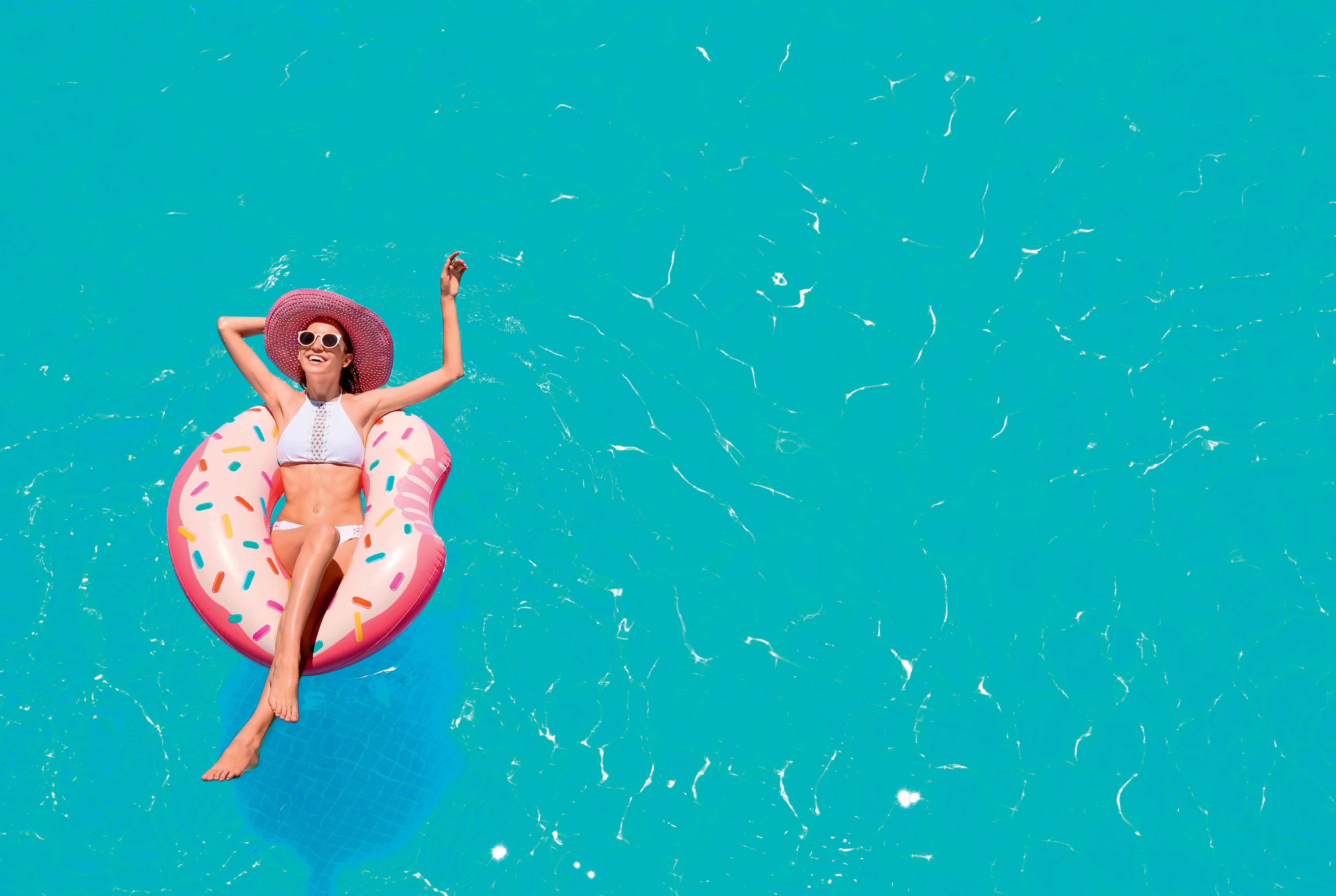




Low maintenance is a term that is rarely associated with pool ownership. In years gone by, the work required to keep a pool in tiptop condition and looking the right colour whilst being safe to swim in was enough to turn some people off the idea of pool ownership. However, with pool equipment manufacturers racing to incorporate timesaving technology into their products along with internet integration and apps, we asked Hayward Pool Products whether it really is now truly possible to spend longer in your pool than working on it.
FOR BUSY HOMEOWNERS, WHAT ARE THE BEST CURRENT TECHNOLOGIES AVAILABLE FOR REDUCING THE WORK REQUIRED TO RUN A POOL?
Probably the quickest and easiest thing that you can do to make maintenance easy is to cut down on the time and effort it takes to clean your pool. You can do this by investing in an automatic pool cleaner. It will remove
debris and scrub the pool for you — all you have to do is remember to empty it. The new AquaVac 650 Robotic Cleaner from Hayward has even done away with filters, meaning you can stay away from the mess and empty it with the touch of a button.
A more long-term solution to improve the ownership experience would be to invest in an automation system to run your pool. Many owners install a pool to improve the lifestyle of themselves or their families. In the past they have been unable to fully enjoy this change due to the work required to maintain and run a pool. Automation removes many of these time-consuming and labour-intensive tasks so the owner can enjoy the lifestyle improvements that a pool can bring.
ARE THERE ANY SPECIFIC HAYWARD POOL PRODUCTS THAT YOU’D RECOMMEND FOR A BUSY HOMEOWNER? WHY?
Hayward OmniLogic pool and backyard automation is
the perfect system for a busy homeowner. It provides an easy way to control the chemistry of your pool and spa, as well as the heating, lighting, water features and any other pool or backyard equipment required by the user. The system takes the hassle out of pool ownership by bringing together all the elements of a modern energy-efficient pool and allowing the user to control it with an app. With an OmniLogic installed you can quickly and simply get your pool running exactly how you like it, at the touch of a button.
Owners can access their pool from anywhere as long as they’re connected to the internet. So rather than having to manually switch valves or press buttons around the pool, the owner can do this from the comfort of their sun lounger. You can even get
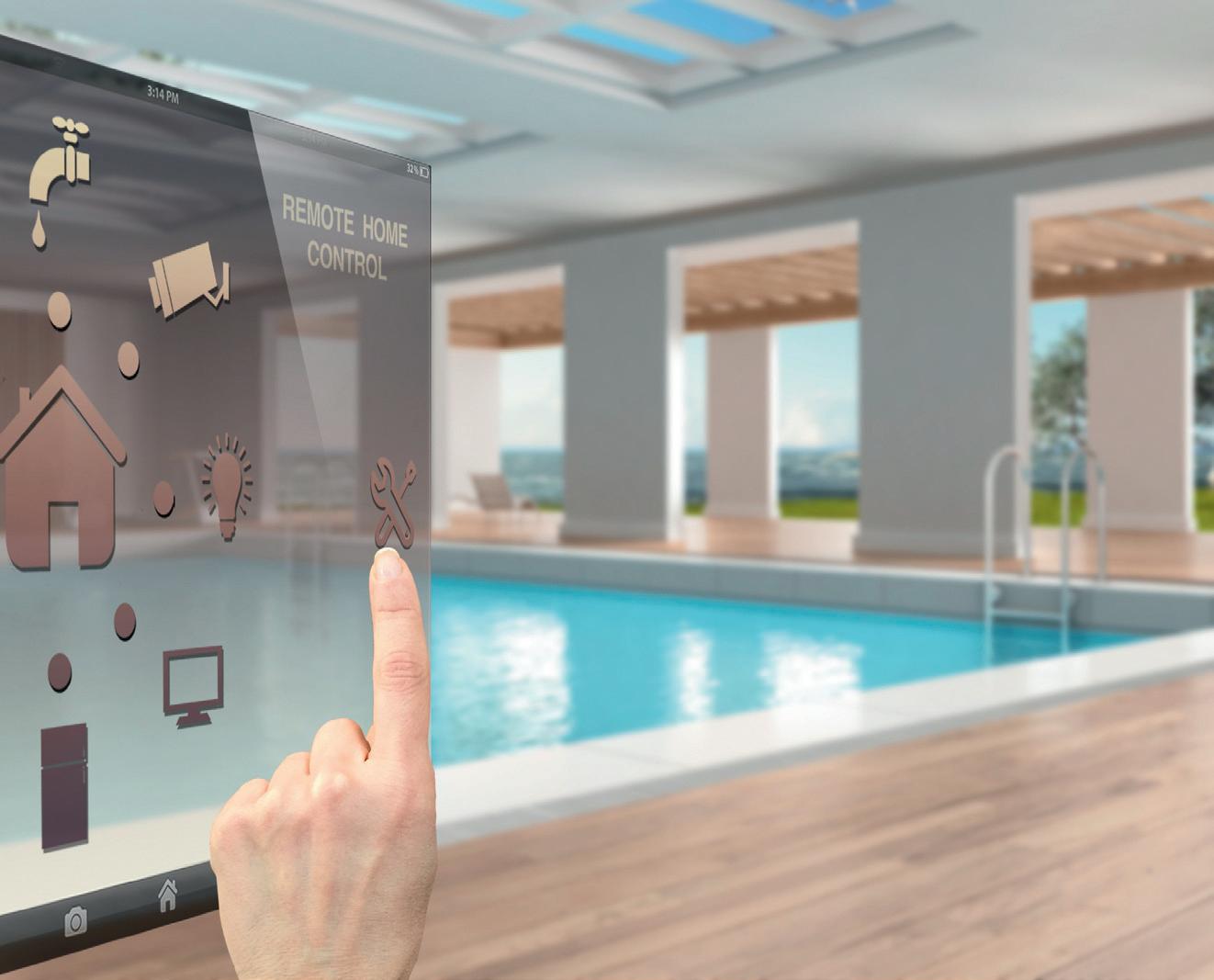
your pool up and running before you arrive home from work, allowing you to get straight in and make the most of your evening.
When choosing your pool equipment make sure that you are comfortable with understanding how it operates — modern systems can appear complicated and this can be off-putting to some people. The last thing you want is to be standing around scratching your head trying to figure out how to get your filtration running when you could be in the pool splashing around. However, if a system is set up in accordance with the needs of the pool owner and a good handover is provided by the installer, pool automation can truly transform your ownership experience and turn it into the dream you always hoped it would be.
To find out more about the products mentioned in this article and to find your nearest Hayward dealer, just head to www.hayward-pool.com.au.

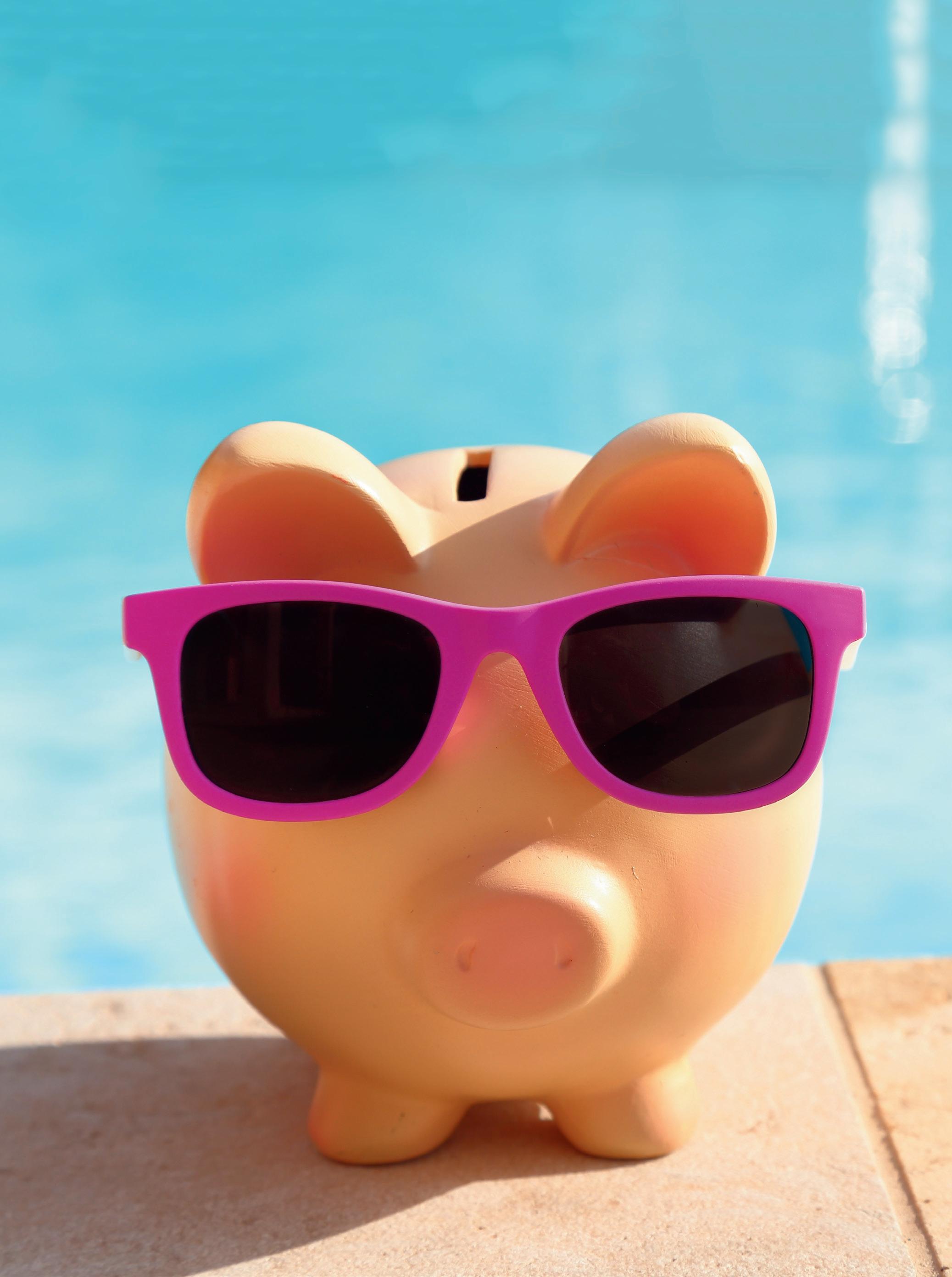

In the dark when it comes to how much your pool costs to run each year? You may have a vague idea, but seasonality impacts on pool usage, chemical requirements, evaporation and energy use, making it hard to determine an annual figure.
If you don’t have a handle on your current outlay, you can’t know if there’s potential to save money — something that plenty of homeowners are keen to do in times of rising interest rates.
There are three basic areas of expenditure: energy consumption, water usage and chemical costs, all of which are subject to fluctuation throughout the year.
When it comes to energy use, there are plenty of variables in the equation including the type of equipment and how long you run it each day. Your geographic location has a massive influence on the retail kilowatt hour (kWh) price, which varies wildly from state to state across Australia and regionally throughout NZ.
Water consumption is based on evaporative loss, which obviously increases over hot summer months. Evaporation is generally offset to some degree by rain, but changing weather patterns can throw the numbers out from one quarter to the next.
Finally, there are chemical costs — something that varies from household to household but can be reasonably approximated for the year if you know which chemicals you use, the water volume your pool holds and the average per kilo price of each specific product.

It’s no surprise that energy costs are spiralling. We’ve been told to expect continued increases for at least the next couple of years due to a range of external forces including a reliance on fossil fuels, profiteering by gas corporations off the back of the Russia–Ukraine conflict and an aging local energy infrastructure.
While renewables like solar and wind are on the rise, our national energy system still relies heavily on coal and gas. According to the Climate Council, the wholesale prices for both have roughly quadrupled since the 2020–21 financial year and those increases have naturally been passed on to the consumer.
Depending on the individual setup, the average pool uses power for a range of functions including filtration, cleaning and heating. Swimming pool heating is a comprehensive energyrelated subject in its own right and we’ve written about it extensively in past issues of the magazine and on our website blogs. You can find plenty of information on the available types of pool heating on the Pool & Spa website. Just visit www.poolspalife. com.au and search ‘heating’.
For now, we’ll concentrate on the filter pump — one of the more energy-intensive pieces of pool equipment. The pump works hard to maintain a clean and algae-free pool, running probably six to eight hours a day in summer and four or so in winter. The trick here is to aim for one of the more energy-efficient models — as a rule, a variable speed pump offers benefit over a single speed variety, as lowering the speed means the pump is not working as hard at specific times throughout the day and therefore drawing less power.
Australia’s E3 Program requires swimming pool pumps to feature an energy rating label, which includes the pump’s energy consumption figure in kilowatt hours based on standardised testing (using a 50,000 litre pool as a benchmark) and assigns a star rating from one to 10 stars, with 10 being the most efficient.
Armed with this info and the kWh price your energy retailer charges — which is listed on your bill — you can easily work out the yearly running costs of a specific pump model. Current energy prices are a

bit of a moving feast and subject to huge variances from state to state. For example, in January this year the average kWh price in Victoria was 20.95c/kWh, while it was almost double that in South Australia at 36.11c/kWh, according to consumer comparison site Canstar Blue.
For additional assurance, the Climate Care Certified (CCC) program provides independent thirdparty verification that swimming pool products, systems and installations are designed, manufactured and built to meet market and consumer needs in compliance with all required regulations, standards, licences and codes.
CCC is an initiative of the Swimming Pool & Spa Association of Australia and New Zealand (SPASA) and is recognised as the industry’s efficiency and sustainability certification program. Because participation is voluntary, you know that certified vendors are serious about the industry and the environment. They’re also committed to delivering sustainable choices and innovations that help you make informed purchasing decisions — decisions that reduce water and energy consumption and save you money. You can find further information on the CCC website (www.climatecarecertified.com), including a list of certified swimming pool pumps.
Beyond the initial fill, the bulk of water use in residential pools is compensation for evaporative loss, which varies seasonally and geographically. The evaporation rate is influenced by your pool’s surface area (the width x the length), the temperature of both the air and the water, humidity levels and other ambient conditions including wind.
To give you a general idea, Australia’s Bureau of Meteorology (BOM) publishes averaged annual, seasonal and monthly evaporation
information from across the country based on historical data. It doesn’t allow for rainfall offsets but clearly illustrates the huge water loss variations by season for each region in the country. Not surprisingly, summer is where the action is, and dry heat contributes more to evaporation than high humidity. Based on the BOM’s summer data, the daily evaporation rate for a pool
in Sydney is just over 6 mm, while for Perth, it’s somewhere between 8–9 mm.
So, what does that number mean, relative to your pool? Using those locations as examples: a 6 mm evaporation rate in Sydney equates to six litres of water per square metre every day and a 9 mm evaporation rate in Perth indicates

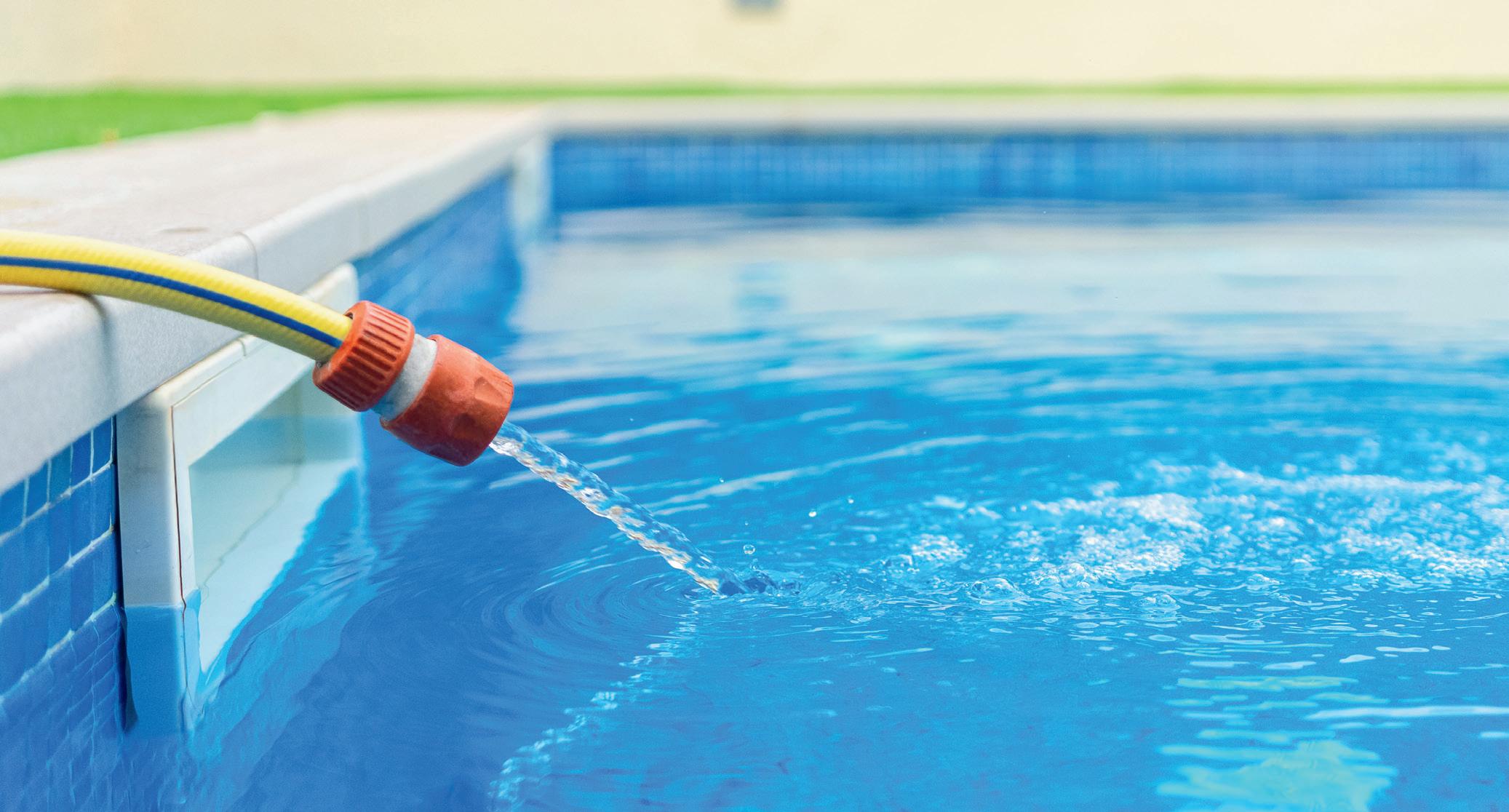
losses of 9 litres per square metre every day.
In Sydney, a 9 x 4 m (36 m 2) pool will lose 216 litres every day and the same sized pool in Perth will lose 324 litres. Looking at a six-month swimming season and averaging out the numbers, it’s conceivable your pool will lose somewhere between 40,000 and 60,000 litres in that time period.
Of course, these figures are only based on averaged BOM data, not on the actual conditions at your place. Evaporation rates are also influenced by things like wind and direct sun exposure and if you are using pool heating. Evaporative losses are higher when the difference between the water and air temperature is greater, which means the real damage might be happening while you’re asleep.
There are three basic areas of expenditure: energy consumption, water usage and chemical costs, all of which are subject to fluctuation.
”
The single biggest thing you can do to minimise evaporation is to utilise a pool cover, which can limit losses by more than 95% when correctly fitted. Covers and blankets also keep leaf litter out of the pool — which has a flow-on effect for cleaning and chemical use — and can trap heat, keeping the water toasty and extending the swimming season even longer. For more information, check out the certified covers and blankets listed on the CCC website.
To get a general number, take a look at your last water bill and find the kilolitre (kL) unit price. At first glance, the final yearly dollar value required to compensate for estimated evaporation may not seem that large, but it’s worth remembering that water is an unpredictable commodity and that retail kL pricing can — and does — change quickly. For example, Sydney Water’s current household water usage charge is $2.50/kL, with a disclaimer that it will increase more than 50% (to $3.38/kL) if dam levels drop below 60%, a metric that’s out of everyone’s control.
Depending on the type of pool (saltwater, mineral or freshwater) system you have and the sanitisation
method you are using, there will be some cost associated with the use of chemicals — whether for sanitisation, water balance or other specialist treatments.
Of course, pool water has to be adequately sanitised, which in many cases means using products like sodium hypochlorite, calcium hypochlorite or salt (when combined with a saltwater cell) to kill bacteria, algae and other contaminants.
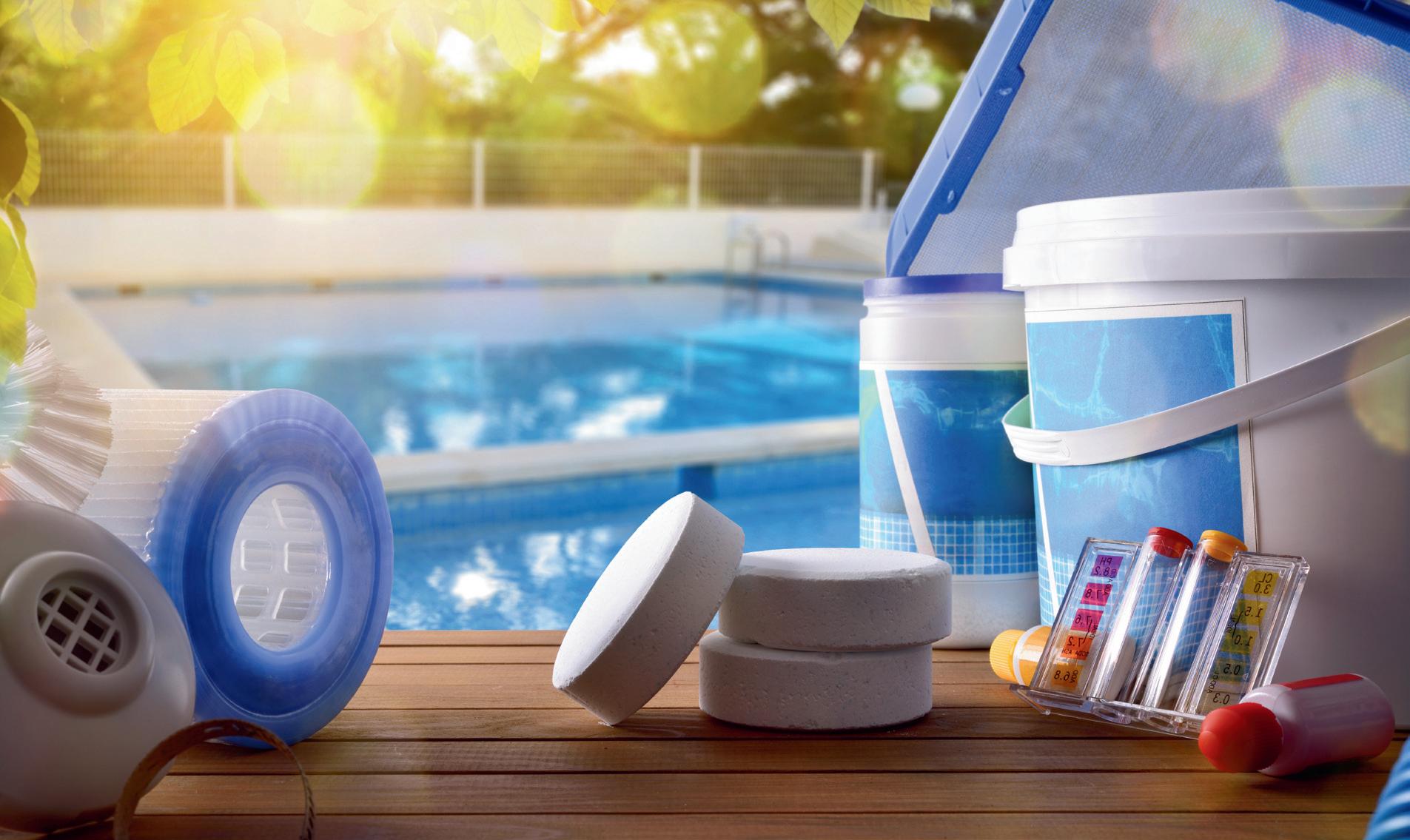
Then there are additives to balance the water — to ensure total alkalinity is stable, to raise or decrease pH levels, to ensure that calcium levels are maintained and ensure the sanitiser in your pool is protected from UV rays, which can degrade or burn off the effectiveness. In addition to these basics, there are other specialist products like algaecides, phosphate remover (algae feeds on phosphate), clarifiers, stain and scale prevention products and shock treatments.
Every pool is essentially a unique chemical equation, no matter what type. The inclusion of one chemical or additive can create a need for another to ensure the perfect water conditions. For example, mineral swimming pools use less chlorine than a saltwater chlorinated pool, but the addition of potassium and magnesium can often increase water
hardness. Depending on the mineral mix you use, this may then require a chemical softener to compensate.
While this can seem a bit overwhelming and reads like a laundry list of confusing products, your specific pool is its own environment. It will require some or all of these additives in varying amounts, depending on your chosen sanitisation method, the other systems employed and the unique conditions of your pool environment. This makes chemical costs a bit of a ‘how long’s a piece of string?’ calculation, but you can safely expect to spend at least a few hundred dollars a year keeping the water in check.
As always, consult your pool shop professional or certified pool technician for accurate advice. Automatic dosing systems can also take the guesswork out of maintenance and have the twofold benefit of making it easier to work out annual chemical budgets. Technology advances are changing the landscape every day, with a focus on saving and sustainability increasingly driving product design. There’s a wealth of information available on the www. poolspalifecom.au website, with links to products and other technical articles that can help point you make better decisions when it comes to your pool.
The inclusion of one chemical or additive can create a need for another to ensure the perfect water conditions.
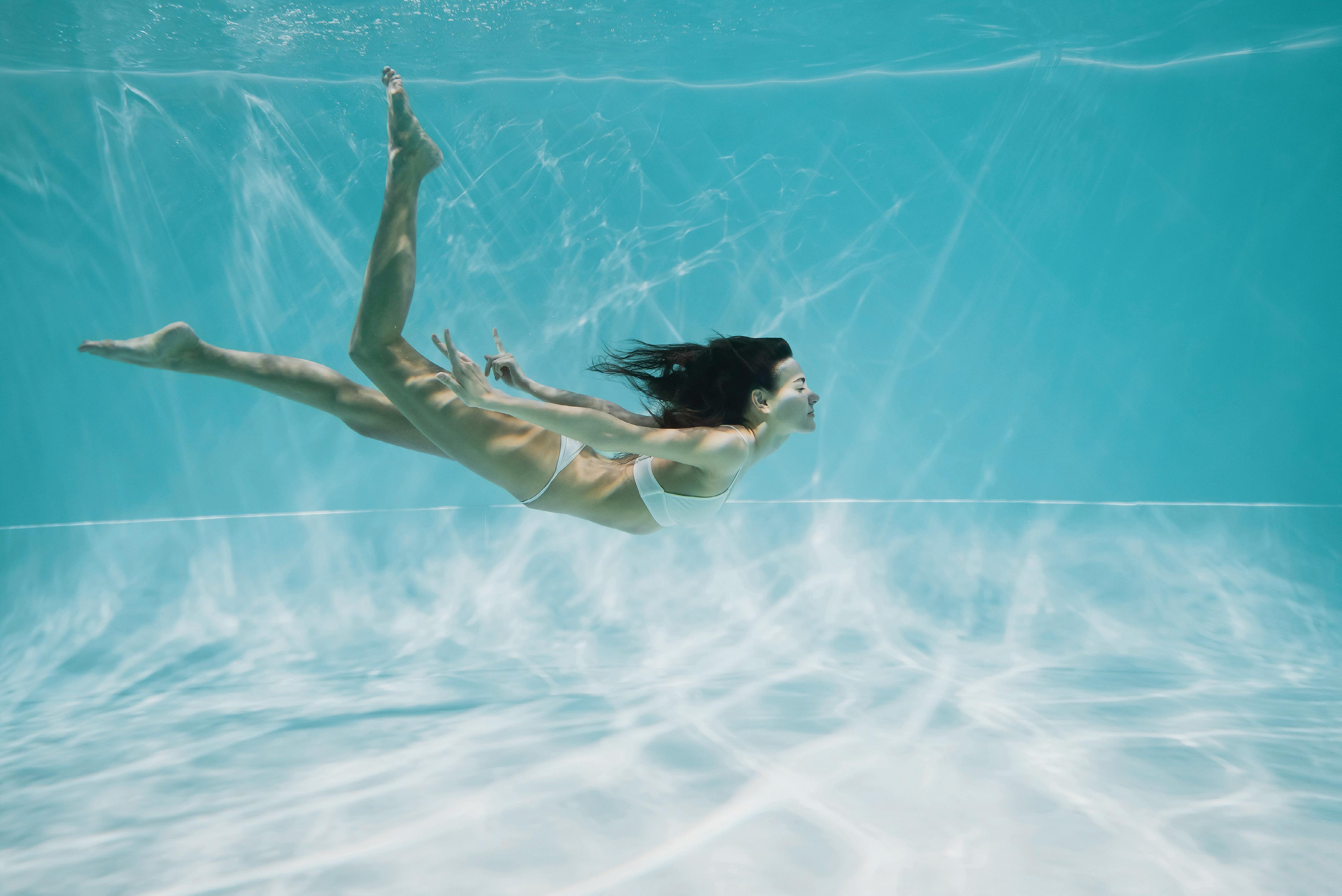


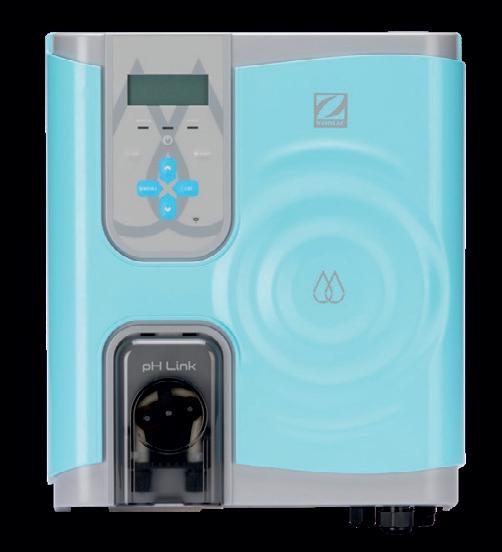
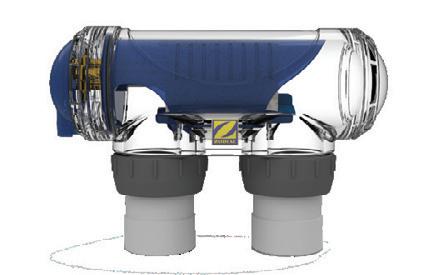

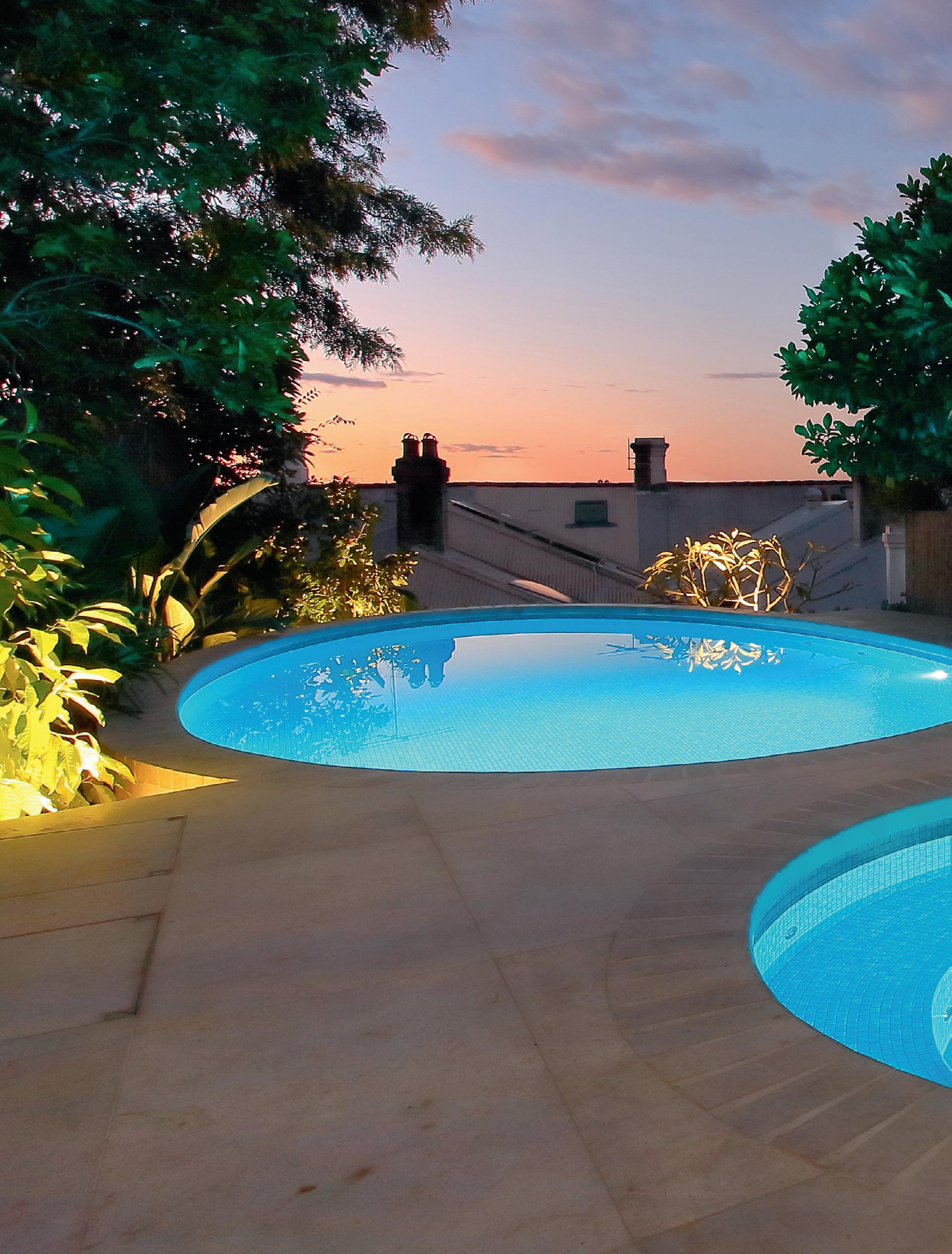
Malibu Pools & Spas is an award winning family owned and operated business. We have been building beautiful inground concrete swimming pools and spas in Sydney and across NSW since 1993.

With the capacity to complete 60 to 90 pools each year, our dedicated team will work with you to design your dream pool, manage all aspects of the building approvals process and provide you with honest and realistic pricing, while keeping you informed at every stage of the process.
For this award winning project, both the pool and spa were above ground and needed to be back-formed. The precision of the concrete placement allowed for seamless integration of the limestone ‘brick’ edging. To ensure everything stays in place, 68 surveyor points were established to position the pool and create the shapes of both the pool and the spa.
P: 0418 499 905
E: ENQUIRIES@MALIBUPOOLSNSW.COM.AU
W: WWW.MALIBUPOOLSNSW.COM.AU
If you’re tired of only being able to use your pool during the summer months, or if you’re looking for a more reliable or energy-efficient way to heat your pool, it’s time to consider an EvoHeat pool heat pump.
EvoHeat is a leading provider of energy-efficient pool heating solutions in Australia, offering cuttingedge technology that can provide you with warm and comfortable pool water all year round. With over 15 years’ experience, EvoHeat have tailored their pool heat pumps to suit the Australian climate, ensuring
optimal performance even in colder temperatures.
One of the most significant benefits of investing in an EvoHeat pool heat pump is the ability to maximise your pool and improve your lifestyle. With an Evo heat pump, you can extend your swimming season to all year round, regardless of the weather outside. Imagine being able to swim in the comfort of your heated pool, no matter the season, and starting your day with a refreshing swim.
Heating your pool also brings added health
benefits, allowing you to exercise and stay active in the comfort of your own home. It provides a great opportunity to bond with your family and friends over a swim, creating memorable moments and experiences that will last a lifetime.
EvoHeat’s pool heat pumps are incredibly efficient — they are designed to use as little energy as possible while still providing reliable heating for your pool. This means that you can heat your pool without breaking the bank. In fact, EvoHeat pool heat pumps
are so efficient that they can save you up to 80% on your pool heating costs compared to traditional pool heaters.
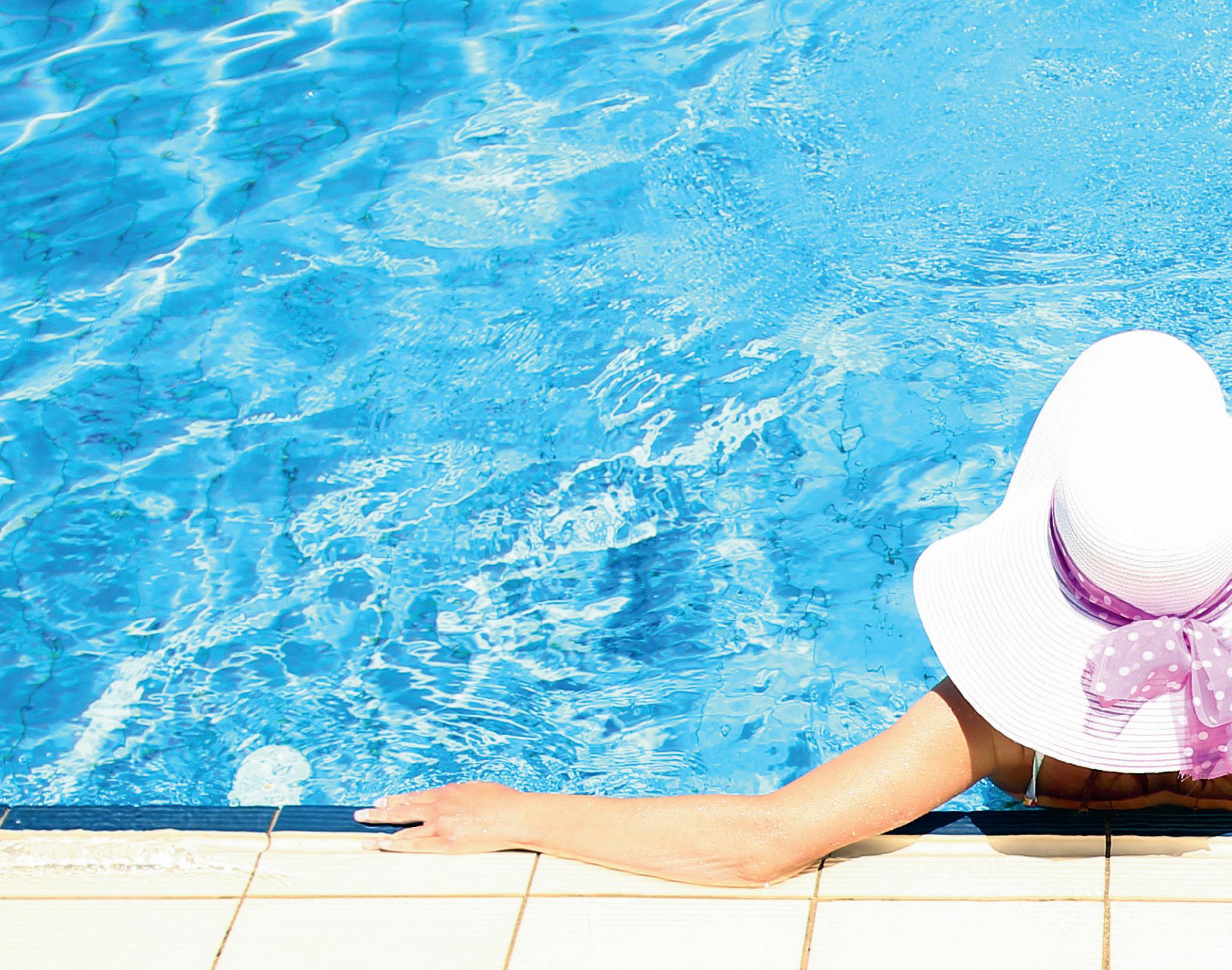
Furthermore, EvoHeat heat pumps can be used with solar PV, allowing you to take control of your pool heating to further reduce operating costs. The intelligent built-in timers allow you to govern when and how long your EvoHeat heat pump operates, so you can make the most of your solar PV energy and offpeak energy tariffs.
EvoHeat’s pool heat pumps are incredibly easy to install and maintain,
requiring no major modifications to your pool or backyard. With regular maintenance, your heat pump will continue to operate efficiently, providing years of reliable service and backed with an industry leading warranty and customer support.
EvoHeat offers a range of pool heat pumps to suit every need and budget. Their entrylevel Fusion-i series is an affordable choice for those looking for a cost-effective solution, while their highperformance Force-i series offers advanced features like the lowest operating
costs, smart controls and Wi-Fi connectivity. No matter which model you choose, you can rest assured that you’re getting a high-quality pool heater that will provide you with years of warm, comfortable pool water.
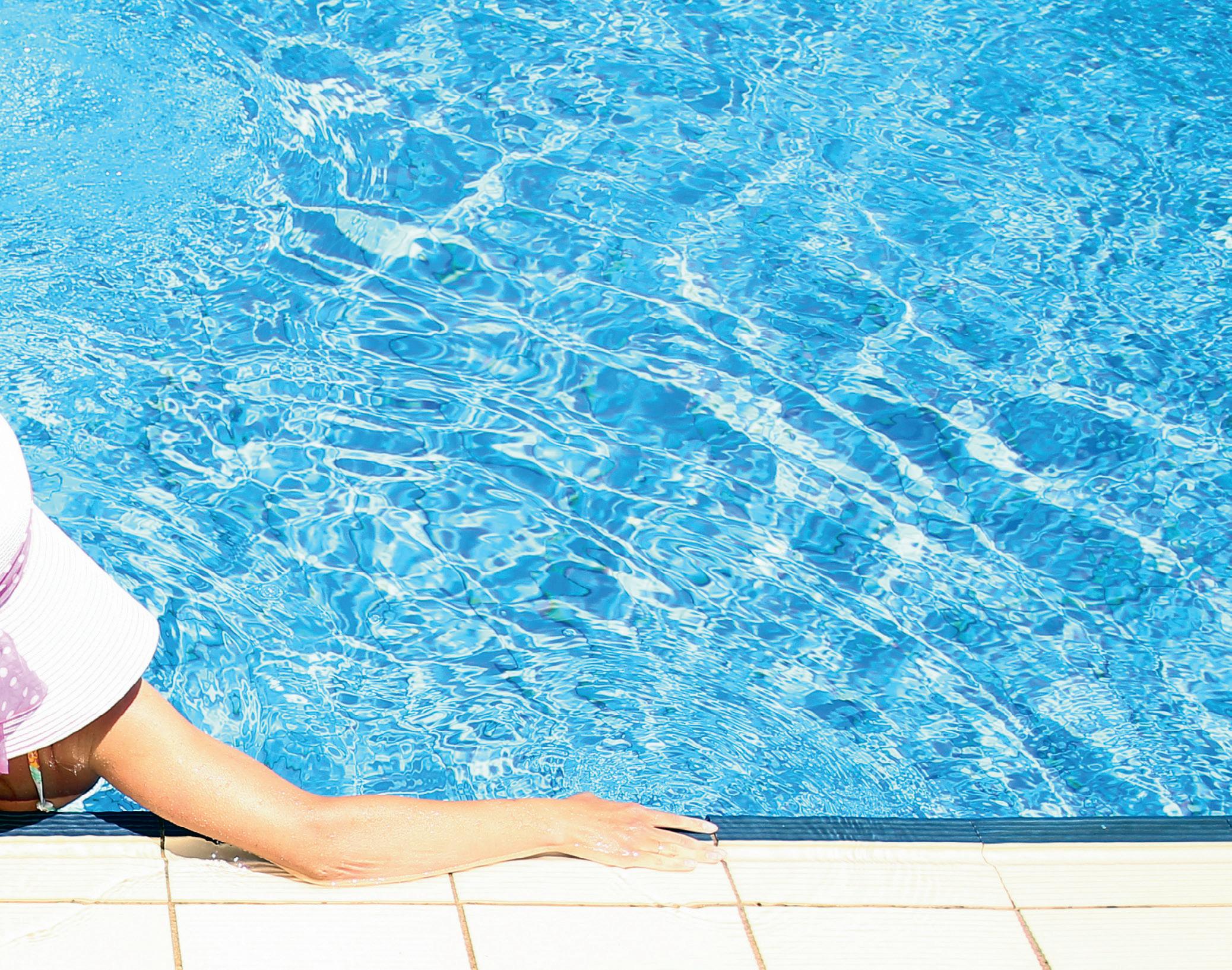
Don’t just take our word for it — see what other Australian homeowners have to say about EvoHeat’s pool heat pumps.
“Our EvoHeat heat pump has transformed our pool and extended our swimming season. We can now enjoy our pool all year round,” said one satisfied customer.
“The installation was effortless, and the team at EvoHeat was incredibly helpful throughout the process.”
Don’t let your pool turn into a water feature this Autumn, contact EvoHeat and ask for your free quote
today. They will provide you with a no obligation quote that includes your estimated running costs, water temperatures and recommended heat pump size based on your pool environment and swimming requirements.
EVOHEAT
P: 1300 859 933
E: INFO@EVOHEAT.COM.AU
W: WWW.EVOHEAT.COM.AU
SKIN AND HAIR FEELING THE EFFECTS OF A LONG HOT SUMMER? THESE TIPS WILL TURN THINGS AROUND IN NO TIME.
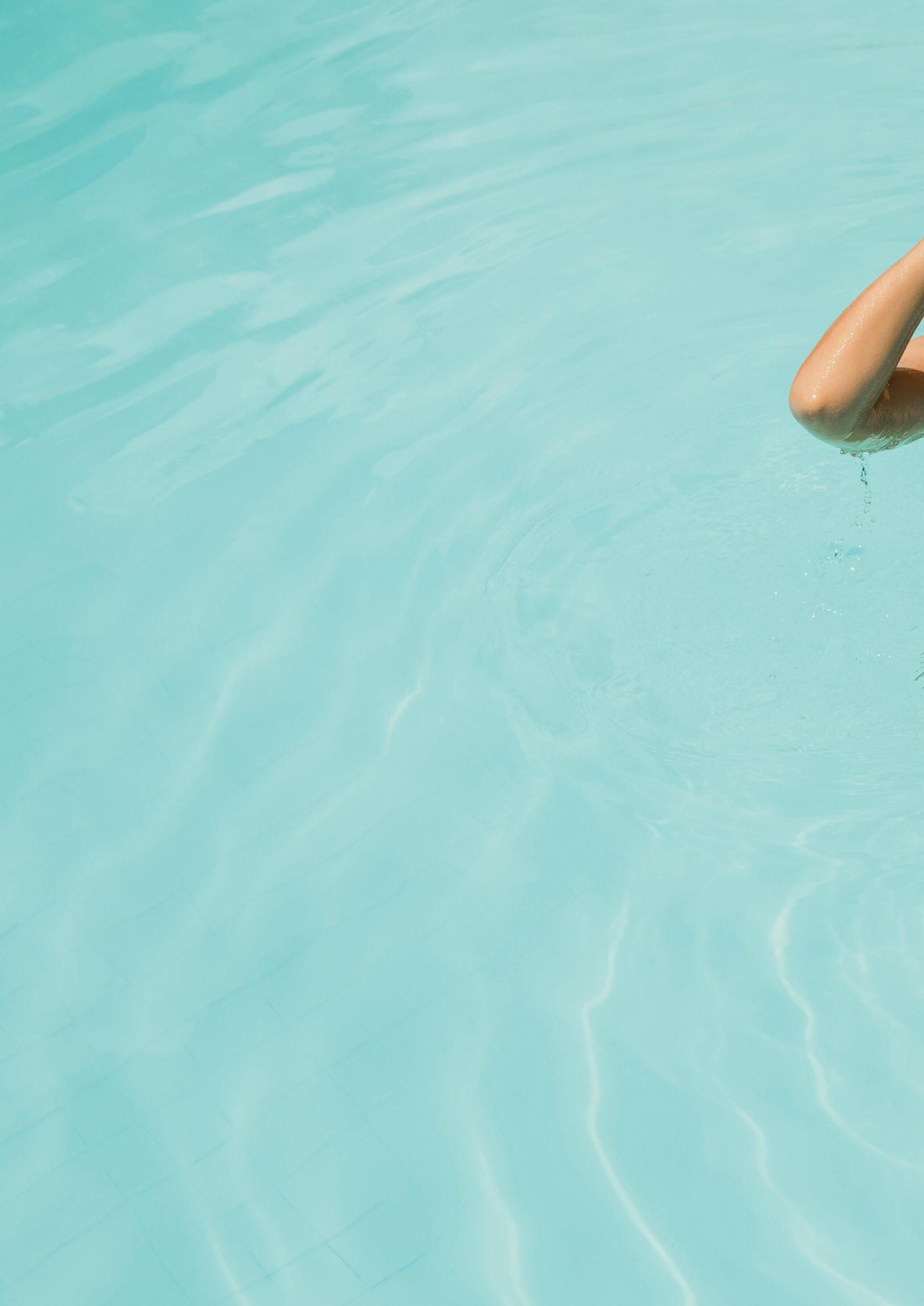
Most Australians and New Zealanders are pretty sun smart. We know the mantra and you can count us to slip on a shirt, slop on some sunscreen and slap on a hat without even thinking about it, thanks to effective ad campaigns over the years.
While we (rightly) focus on the major effects of too much sun, there are some less serious consequences from months of daily swims and sunshine. Some pools use mineral blends or hybrid sanitation systems — these are often more suitable for swimmers with allergies, as they tend to be gentler on the eyes and skin than chlorine and salt alternatives. For anyone feeling like summer has taken its toll and left your skin and hair a little dry, here are some tips to restore health and vitality.
Our skin is an amazing barrier, but it’s not immune to the effects of some pool chemicals and additives. The effects of exposure are different for everyone and can range from no reaction or a very mild dryness through to more uncomfortable conditions including redness, itching and flaking. Nails can suffer as well, becoming dry or brittle. So, what can you do to counter the effects?
STAY HYDRATED
Sound advice year-round, it pays to stay hydrated. Drinking water won’t directly hydrate the skin, but it’s great for your body at a cellular level, flushing the system and helping deliver nutrients where needed as it is absorbed into the bloodstream.
Showering before a swim minimises contaminants like skin oils going into the pool, which means you’ll need less sanitising product. A quick shower afterwards using a moisturising soap or gel limits any chemical absorption through the skin which can lead to dryness.
Avoid hot showers — before and after swimming — as they can open pores
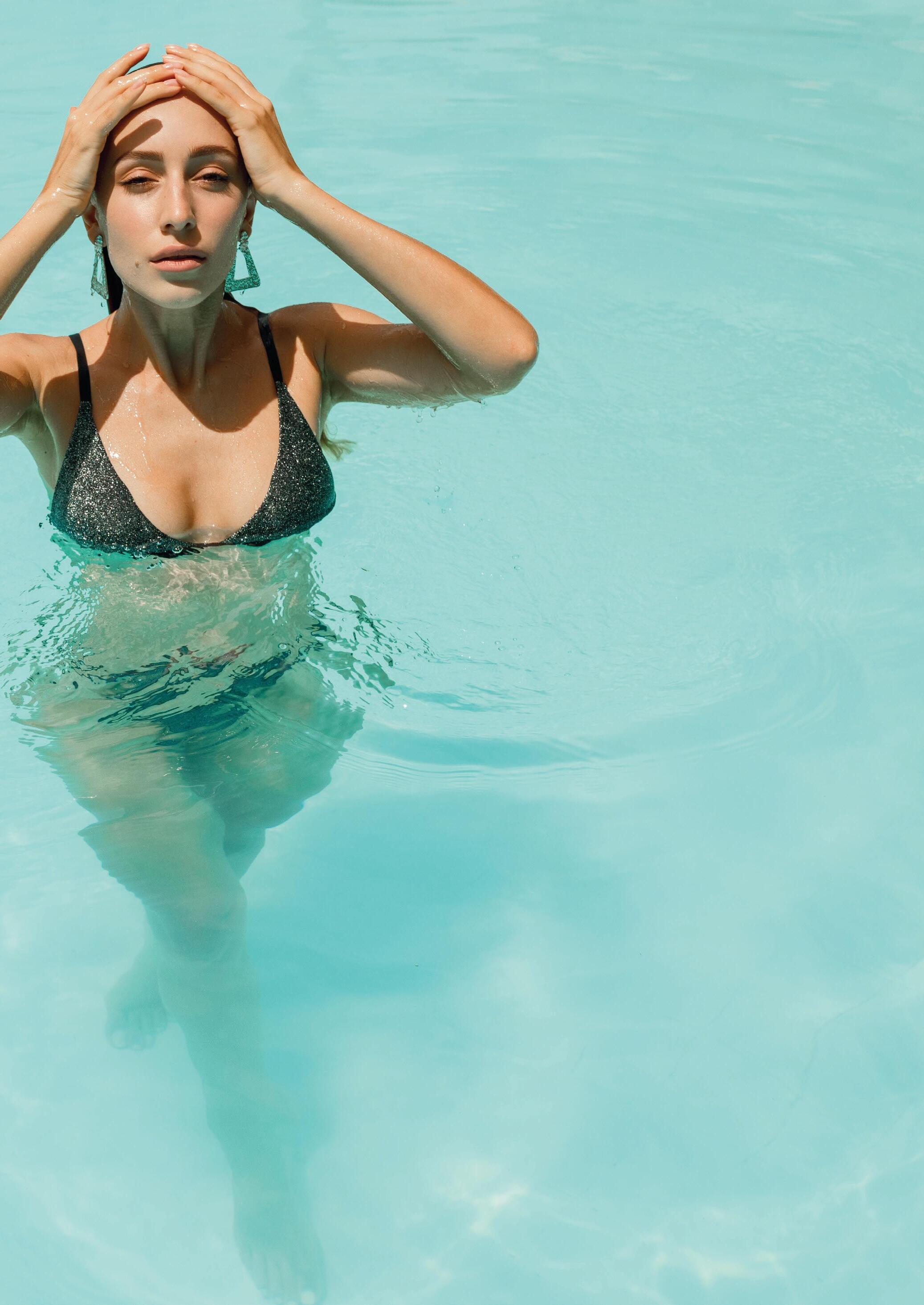
and speed up absorption, as well as disrupting the natural balance of oils and fats, which can inflame and dry out the skin.
Pat your skin dry gently with a towel and avoid unnecessary rubbing, which can irritate. Moisturise using a cream or lotion with a natural oil base, like shea or cocoa butter, or add a skinrejuvenating oil (like Vitamin E) for extra conditioning. Pay attention to areas that need a little more help, like

elbows and the heels of your feet and be sure to give a little love to nails on both your fingers and toes.
While rubbing with a towel is not recommended, a regular whole-body soft exfoliation will help remove dead skin cells keep your skin looking smooth and soft. You can whip up a homemade scrub by mixing sugar and a neutral oil like olive or coconut. Apply in the shower, massage lightly and rinse off carefully. Pat dry and moisturise as normal.
What’s on the inside counts too, so make sure your diet includes foods that are rich in omega-3 fatty acids — they regulate the skin’s oil production and can help balance hydration and sooth irritation.
Eggs are high in omega-3s, as are fatty cold-water fish like tuna and salmon, anchovies and sardines. Shellfish sources include oysters, mussels, scallops, clams and prawns. For vegetarian and vegan options try flaxseed, walnuts, chia seeds and soybeans.
Showering before a swim minimises contaminants like skin oils going into the pool.
Dry and brittle hair can be a common condition after months of exposure to sunshine and swimming. For some swimmers, the results are more noticeable — like hair discolouration or a dry, red and itchy scalp. Before you reach for the scissors to chop it all off, try some of these tips to soothe any damage.
PRE-SWIM
A lot of hair care advice involves slathering your hair in a natural oil — coconut, olive, jojoba or avocado for example — to act as a barrier between your hair and the pool water, limiting discolouration and alleviating dryness.
While your hair may thank you, it’s not necessarily the best advice when it comes to water chemistry. The same issue applies to commercially available options, like leave-in hair conditioners. Introduction of these and other personal products — like sunscreens, deodorants and perfumes — creates a need for additional sanitising material to balance the water… and so the cycle continues.
If you really want to create a barrier between your hair and the water, use a swimming cap made from silicon or latex.
POST-SWIM
Rinse your hair immediately after a swim and be sure to shampoo and condition using a clarifying or pH balancing shampoo, or one designed specifically for use after swimming.
This is the time to use leave-in conditioners, provided you rinse the product out before you hit the pool again.
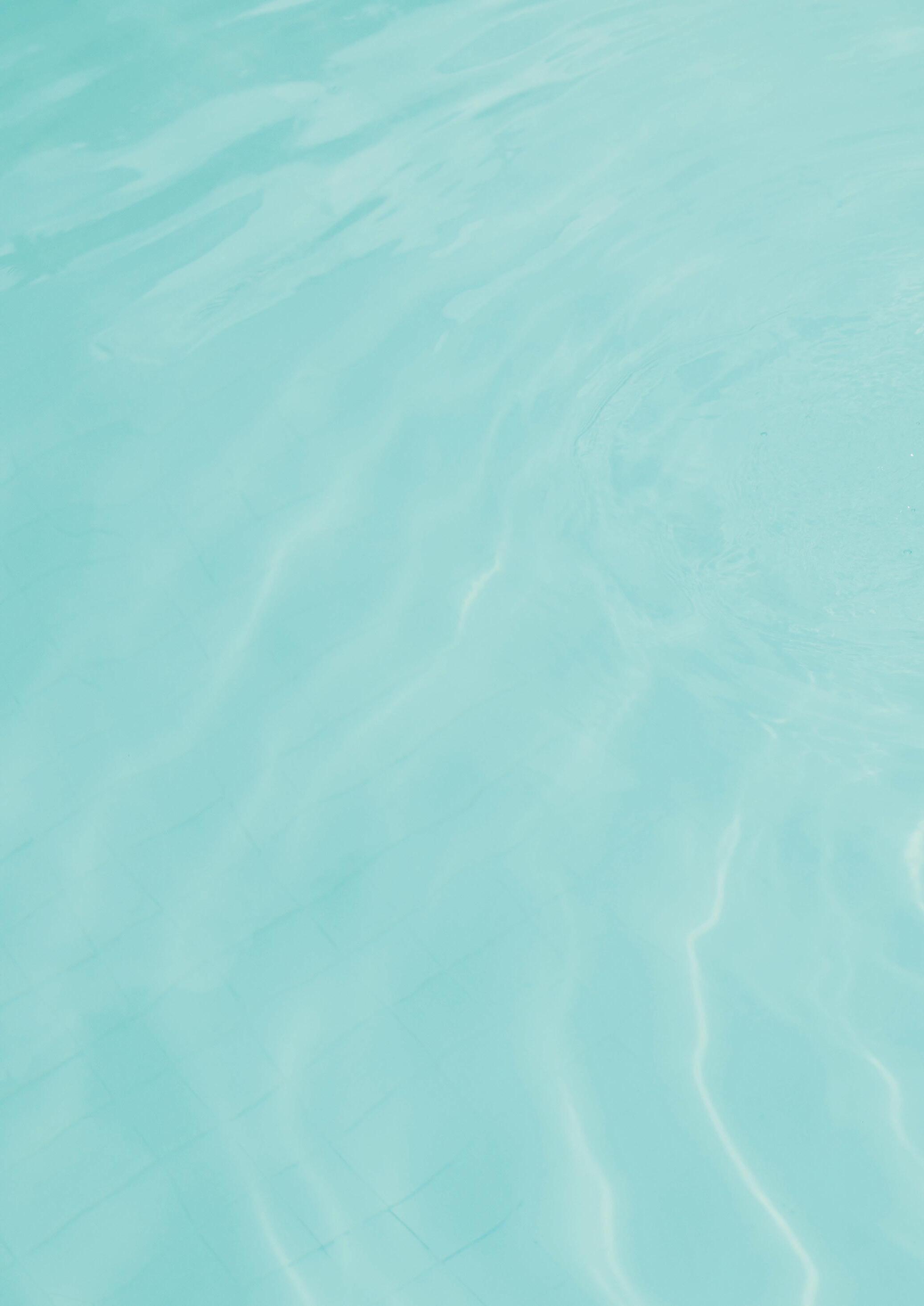
Hair masks are a great way to inject a little extra moisture into dry hair. There are plenty of salon and supermarket alternatives, or you can mix up your own using common kitchen and bathroom ingredients — get googling!
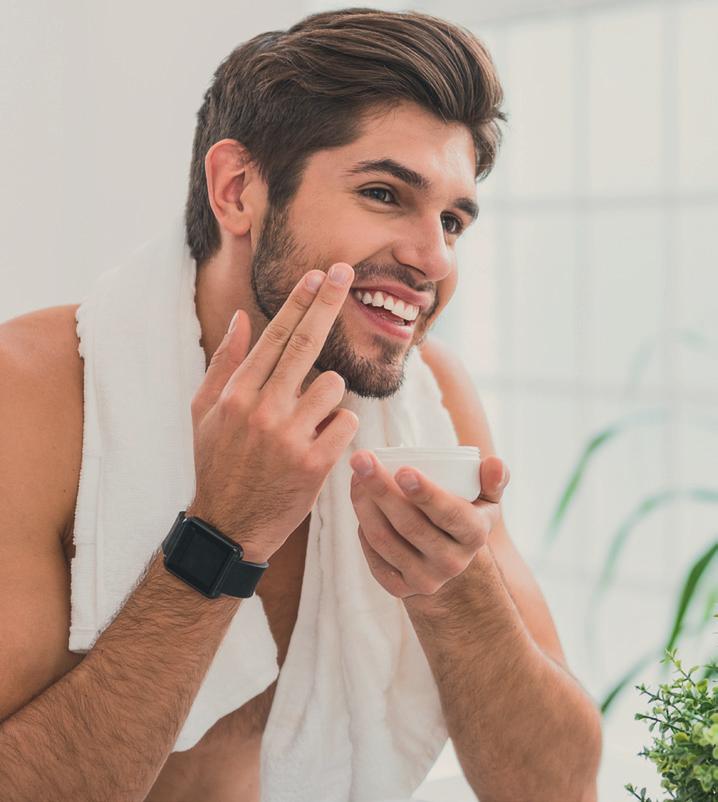
Looks can be deceiving when it comes to hair health and brittle split ends can make the whole length of the hair shaft appear worse than it actually is. Keep up a routine of regular maintenance trims throughout the year to keep your hair looking healthy.
The benefits of swimming are undisputed and a little dryness may seem like a small price to pay for months of exercise, entertainment and relaxation. But you don’t need to suffer — just follow these tips to restore and regenerate hair and skin and keep you looking your best.

While your hair may thank you, it’s not necessarily the best advice when it comes to water chemistry.




Shorter days and cooler weather may signal the arrival of autumn, but that doesn’t mean pool maintenance is over for the year. It’s not quite time to winterise, but your pool could probably do with a little TLC after a busy summer.
Autumn can be mild in parts of Australia and New Zealand — so there’s life in the swimming season yet — but performing a few simple checks now may save on costly repairs down the track. Use this checklist as a guide to keep everything on track as the seasons change.
It’s obvious, but you can expect to see increased leaf litter and debris in autumn, so get ready to scoop or adjust cleaner settings to suit the load. Give the pool a scrub including interiors, tiles, decking and surrounds.

You want everything operational as leaf drop increases. Make sure you’ve emptied the filter and inspected it to ensure it’s running efficiently.

Keep an eye on pH levels, as variations will reduce the efficacy of chemicals and lead to problems. If water chemistry isn’t your thing, take a water sample to your local pool shop for testing and expert advice.
Depending on your location, you can probably squeeze a few more weeks out of the season, particularly if your pool is heated. Check settings and adjust to compensate for chillier days and nights.
If you want to get ahead on winter prep, head to the www.poolspalife.com.au website and search ‘winter’ for everything you need to know. Your pool is a major investment, so it’s important to take the time to protect it. If life gets in the way, speak to a SPASA member who can help ensure everything stays in tip-top condition, no matter what season.

Using a pool blanket or cover will minimise heat loss and evaporation, while helping keep debris out.
If you aren’t swimming every day, changes and problems can go unnoticed. Keep an eye on water and chlorine levels and remember to check and empty the skimmer basket. Take advantage of lower usage to inspect for more serious issues like leaks or tile damage.


Spa World is a fast-growing business selling Fisher, Vortex and Jacuzzi spas and swim spas from its showrooms across Australia and New Zealand. The company was recently awarded International Distributor of the Year at the global Jacuzzi conference.
Putting health and wellness first, Spa World is the world’s first carbon neutral spa retailer and a major sponsor of KidsCan and Make-a-Wish Foundation, as well as other charities. Spa World is owned by Vortex Leisure, a company that manufactures and distributes to 20+ countries.
For this award winning installation, the client was an active Canberra family that wanted a swimming pool as part of a large backyard landscaping project. They opted for a swim spa so they could enjoy the benefits of hydrotherapy year-round. The swim spa is sunk into the deck to capture the same style and ease of use as a swimming pool.
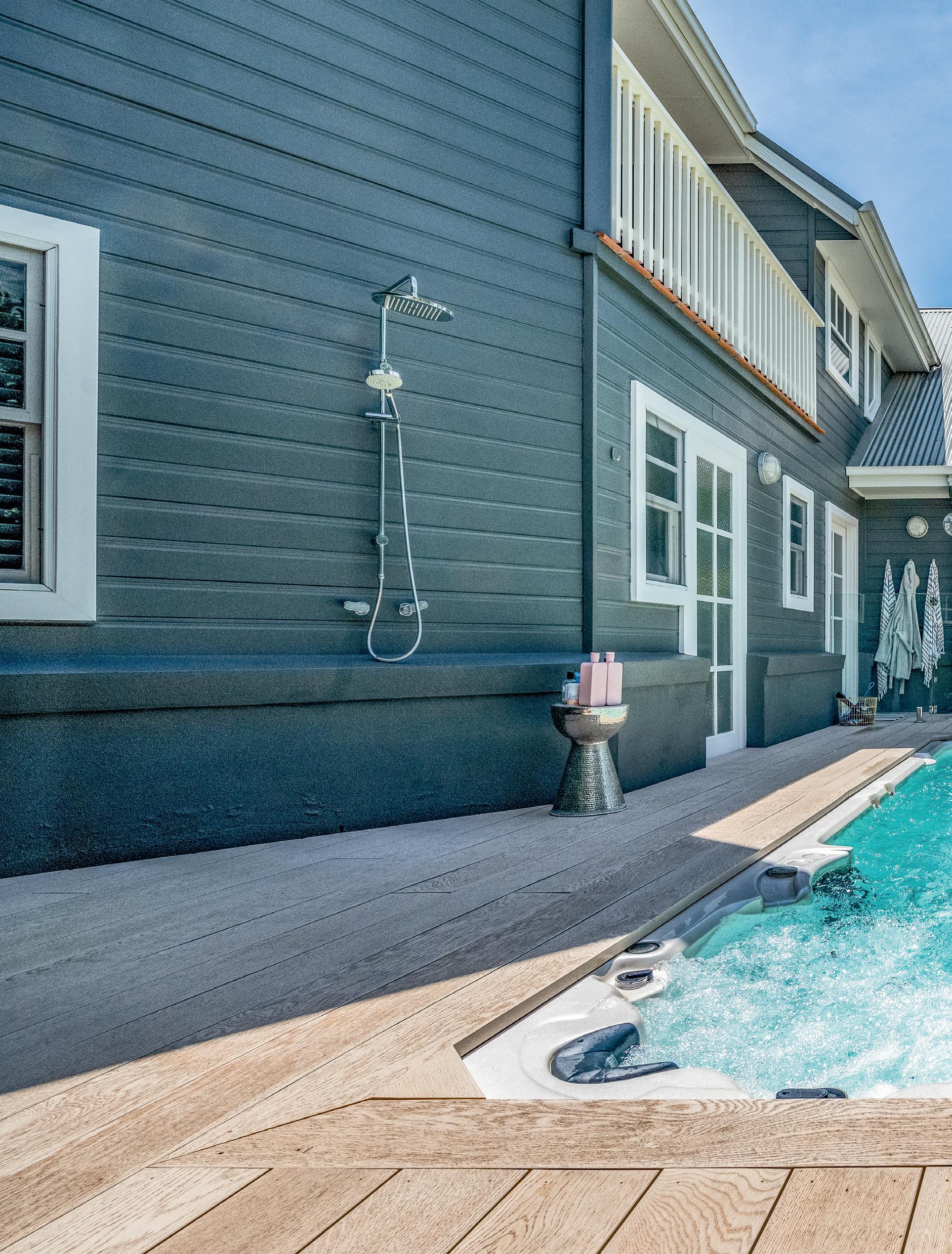
P: 1300 414 187
W: WWW.SPAWORLD.COM.AU

Introducing the Pentair Sta-Rite® Posi-Chlor® Salt Water Chlorinator for healthier, cleaner and silkier pool water. Your pool is your backyard oasis. Now, you can turn it into a spa-like experience with water that feels smooth and silky to the touch. With the Pentair Posi-Chlor® Salt Chlorine Generator, ordinary table salt is converted into pure chlorine, effectively and automatically. You’ll be
able to see and feel the difference.
Easily keep water clear and inviting with electrolytic chlorine generation. The easiest, most effective and convenient way to maintain your pool. Simply adjust the output to achieve the precise level of chlorine.
The Pentair Sta-Rite Posi-Chlor Salt Water Chlorinator does the rest,
automatically producing a steady stream of chlorine for softer, silkier pool water that is free of bacteria and other contaminants. Nothing could be easier.
Standard unpurified chlorine can be harsh to pools and pool water creating an unpleasant experience. Find a safer chlorine option with the Posi-Chlor which uses the Salt Water Chlorination
System. This system produces chlorine directly from the pool water by means of electrolysis of the salt water. “Free chlorine” hypochlorous acid (HClO), is produced and is a strong disinfectant. Saline electrolysis is a reversible process, meaning that once active elements react with organisms present in the water, it reverts to common salt and water. The Posi-Chlor includes an electronic monitoring and

regulation control and an electrolysis cell through which the pool water flows and which is installed in the filtration circuit. This smart chlorinator can help purify water and maintain a clean pool for a better experience.
The Posi-Chlor comes in three different sizes; 15, 25, and 35g/hr. The product features an adjustable chlorine production system through a high-efficiency switched-mode power
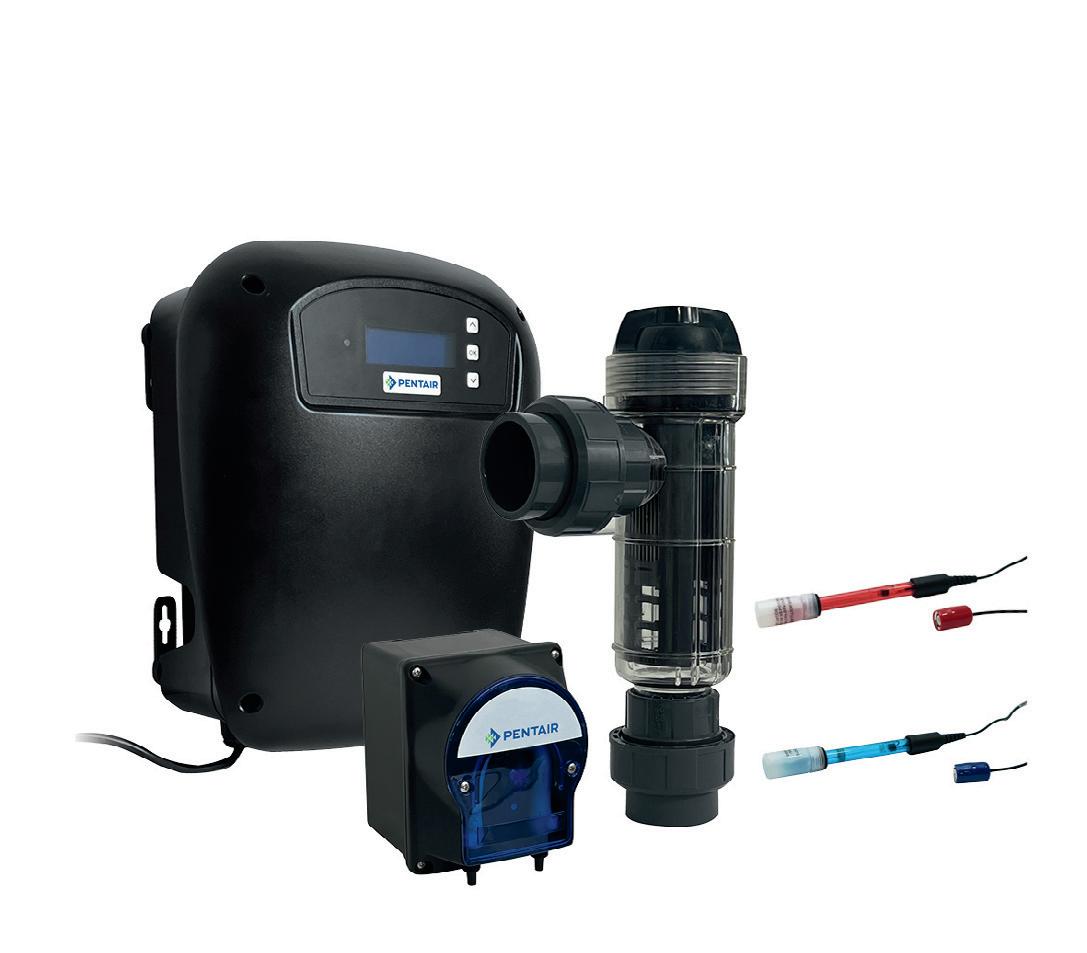
supply, which can be easily adjusted to achieve the desired level of chlorine. This feature makes it easy to maintain the appropriate level of chlorine in the pool, which is essential for ensuring the safety and health of swimmers.
Your pool water, your choice for a healthier you. A choice of product options to suit the pool and the pool owner.

The Posi-Chlor is available in three configurations:
• Basic — With convenient adjustment of chlorine output and filtration pump control with a built-in battery backed-up timer.
• +pH — With an automatic probe-free adjustment of pH, using a smart algorithm.
Dosing is by the peristaltic pump.
• Advanced — This features probes and a fully automatic control of pH and chlorine (ORP). The advanced models offer a more
sophisticated and automated approach to pool maintenance, which makes them a great choice for home swimming pools.
All models feature a high-efficiency switch mode power supply, with over 90% efficiency and automatic voltage adjustment depending on the concentration of salt and the water temperature. This provides a powerful and consistent output to the cell, with very little buildup of heat. Automatic switch-off owing to lack of water flow or due to the accumulation of gas in the cell, with automatic restart once the water flow is restored. In addition,
with optional flow switch input for added safety where required. Posi-Chlor features automatic and adjustable reverse polarity cleaning cycles, which allows a slower or quicker and more aggressive cleaning cycle, depending on the water hardness. With the addition of an optional temperature probe, Posi-Chlor can calculate the salt level of your pool. Posi-Chlor steps it up in smart technology.
Compatible with regular pool and mineral salt blends, you can create a spa like experience in your pool by keeping your pool water clean, pure and silky smooth with the Posi-Chlor Salt Water Chlorinator.
This can really make or break the overall design and help create a natural flow between interior and outside spaces. The good news is, there are material choices to suit every taste and budget, giving you plenty of options to help bring your vision to life.
Beyond aesthetics and economics, there are other factors that help narrow down the options. Your geographic location and the specific site of your pool make some materials more suitable than others, based on exposure to the elements and your local weather conditions.
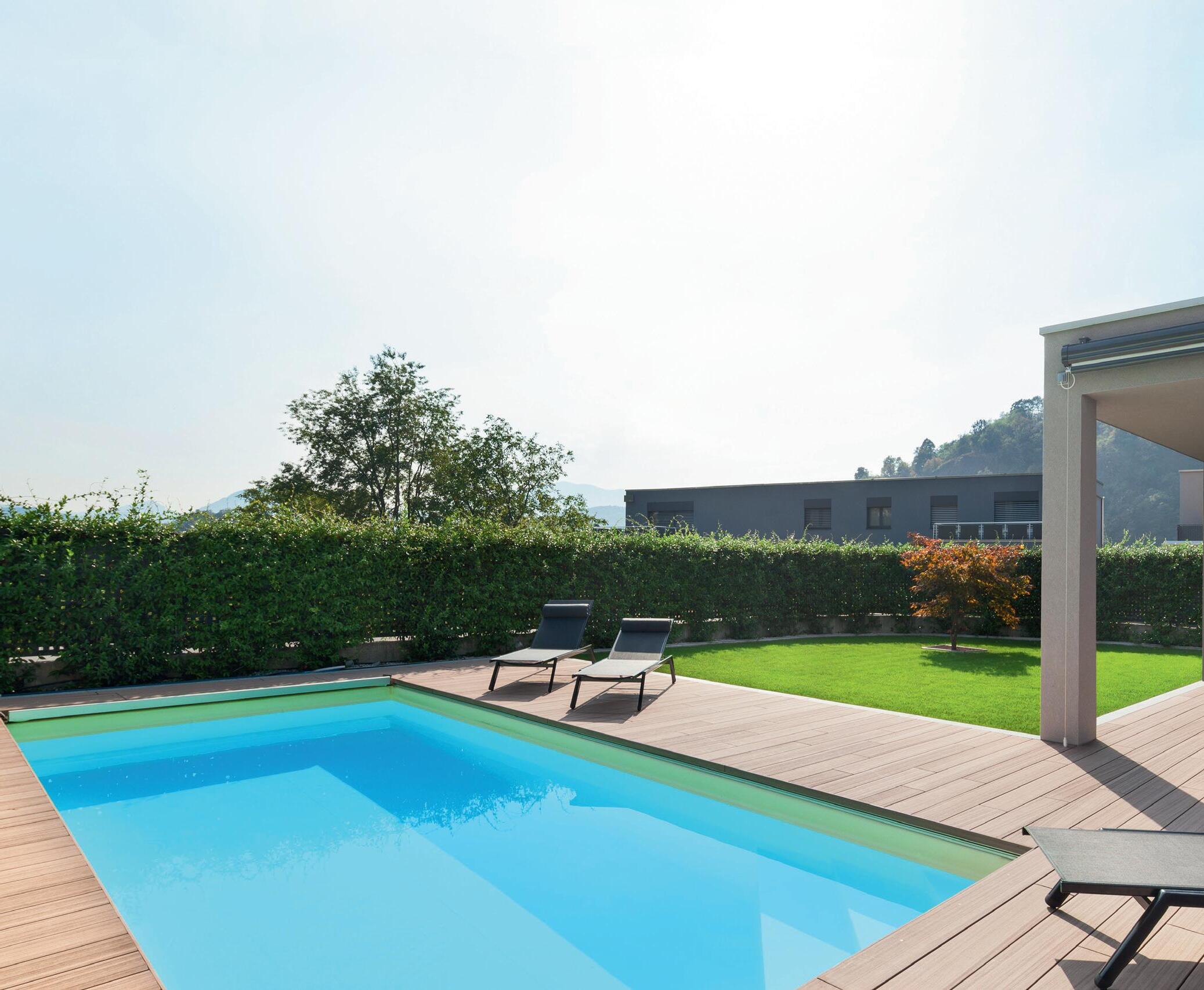
You need to factor in pool chemicals and the sanitation system you use, as the deck will be in constant contact
with pool water and needs to be able to withstand any damage.
From a safety perspective, think about who is using the pool and their relative mobility, or lack of it. It’s important that kids and adults of all ages — not to mention the four-legged members of the family — can move around the pool deck safely. Some materials hold heat, which can make for an uncomfortable walk to the water, while others become slippery when wet and are a safety risk.
Concrete is one of the most durable choices. It’s also pretty versatile and can be coloured and finished to suit any design style — and to look like many other materials. Textured concrete will give you the grip you
ONE OF THE MOST IMPORTANT ELEMENTS OF A SWIMMING POOL BUILD OR RENOVATION IS THE POOL SURROUND, OR DECK.
need and, provided it is properly sealed, it’s easy to maintain. You should get many years out of this option.
There’s no denying that natural stone and paving are good-looking choices. Depending on the specific stone, these are generally hard-wearing, so you won’t need to worry about the lifespan of your deck.
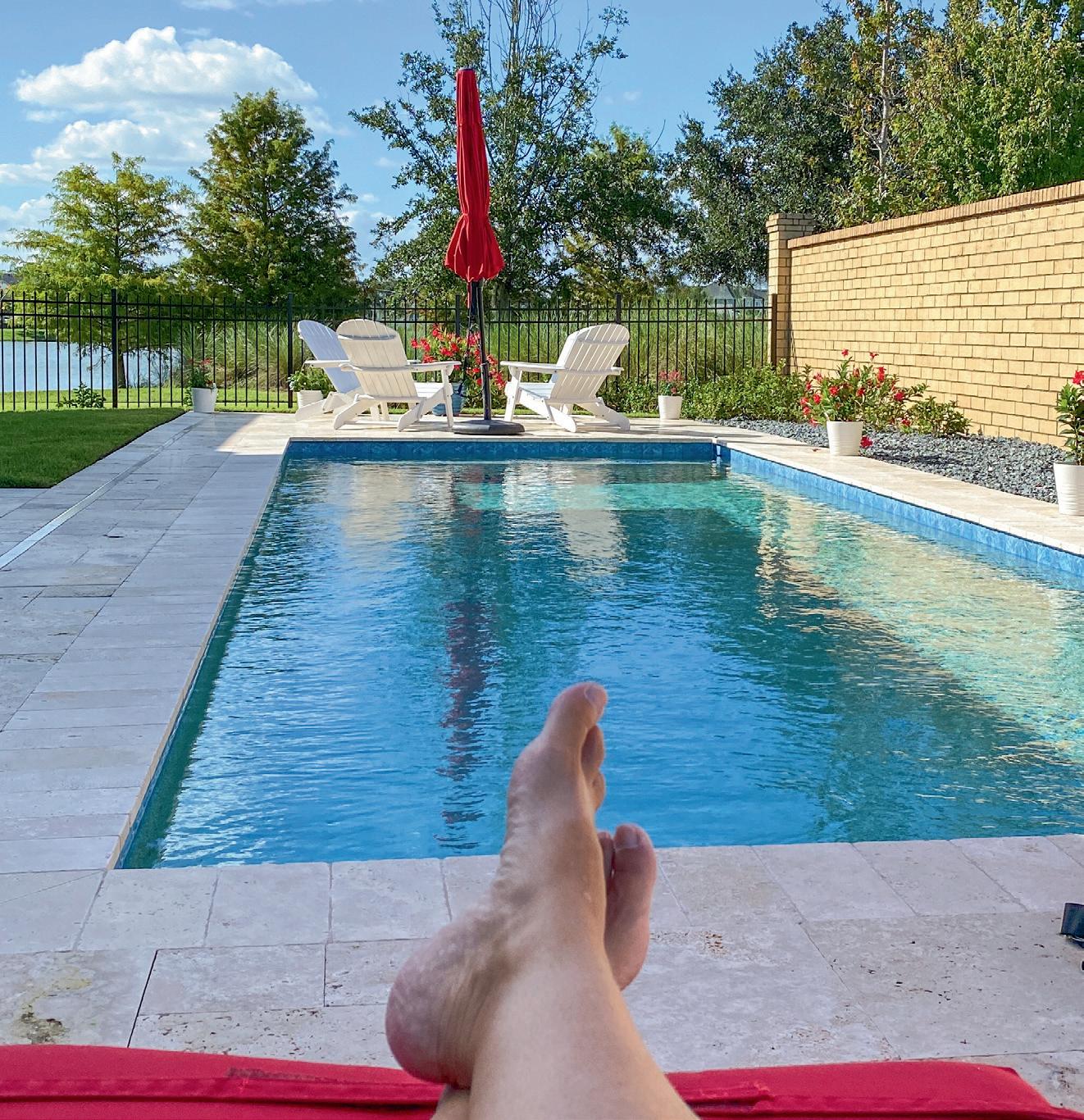

These options are more expensive to lay than concrete, as the process is far more labour-intensive and the material costs are higher. It’s important that installation is done by an experienced professional, as you don’t want pavers or tiles lifting and creating uneven surfaces a couple of years down the track.
Natural stone and pavers will handle exposure to the elements and generally perform well against chemical contact if properly sealed. Some natural stone and paving options may hold the heat, something to consider if your deck is located in full sun throughout the year. Speak to your builder about the best non-slip alternatives — some stone fares better than others here, though it may be possible to apply texture to naturally smooth material to improve grip.
Timber decking may be visually appealing — it gives off a bit of a
rainforest vibe with the right planting – but it is a choice that requires lots of upkeep. You’ll need to oil or paint it at least once or twice a year and should probably completely strip it back and reseal it every three or four years if you want to give it any hope of a long life.
It’s not a great performer when it comes to chemical resistance — both salt and chlorine can wreak havoc. It also degrades far more quickly than other options when exposed to the sun, so cracking, warping and splintering can be an issue. For obvious reasons, timber isn’t well suited to locations where bushfires are a threat.
Composite decking is a manufactured alternative to natural timber. Quality levels vary according to the material construction, which is generally some combination of wood fibre and recycled plastic. The ratio of wood to plastic will deliver products of differing suitability — for example, more plastic may make the product more durable but also more likely to retain heat. If you want to go down the composite road, do your homework. These products are produced both on and offshore, with varying degrees of quality from both. Be sure to get the specific material make-up details from the manufacturer before you commit to anything and ask your builder for client references if you want to hear first-hand experiences.
Generally speaking, composites fall behind other alternatives when it comes to fire resistance, chemical resistance and slip.
A low- (almost no-) maintenance option, aluminium decking is made to look just like timber. It overcomes many of the problems associated with timber and composite decking
choices, as the extruded, powder coated finished product is strong, non-slip, fire safe and capable of withstanding chemicals and exposure to the elements.
It may not offer the sleek finish of a natural stone design, but aluminium is a serviceable and economical option that can mimic the aesthetic of timber without all the hassle.
Your pool surround plays a huge role of the overall look of your outdoor space — often as much as the swimming pool or spa itself — and can be the difference between living with a backyard oasis or a barren landscape.
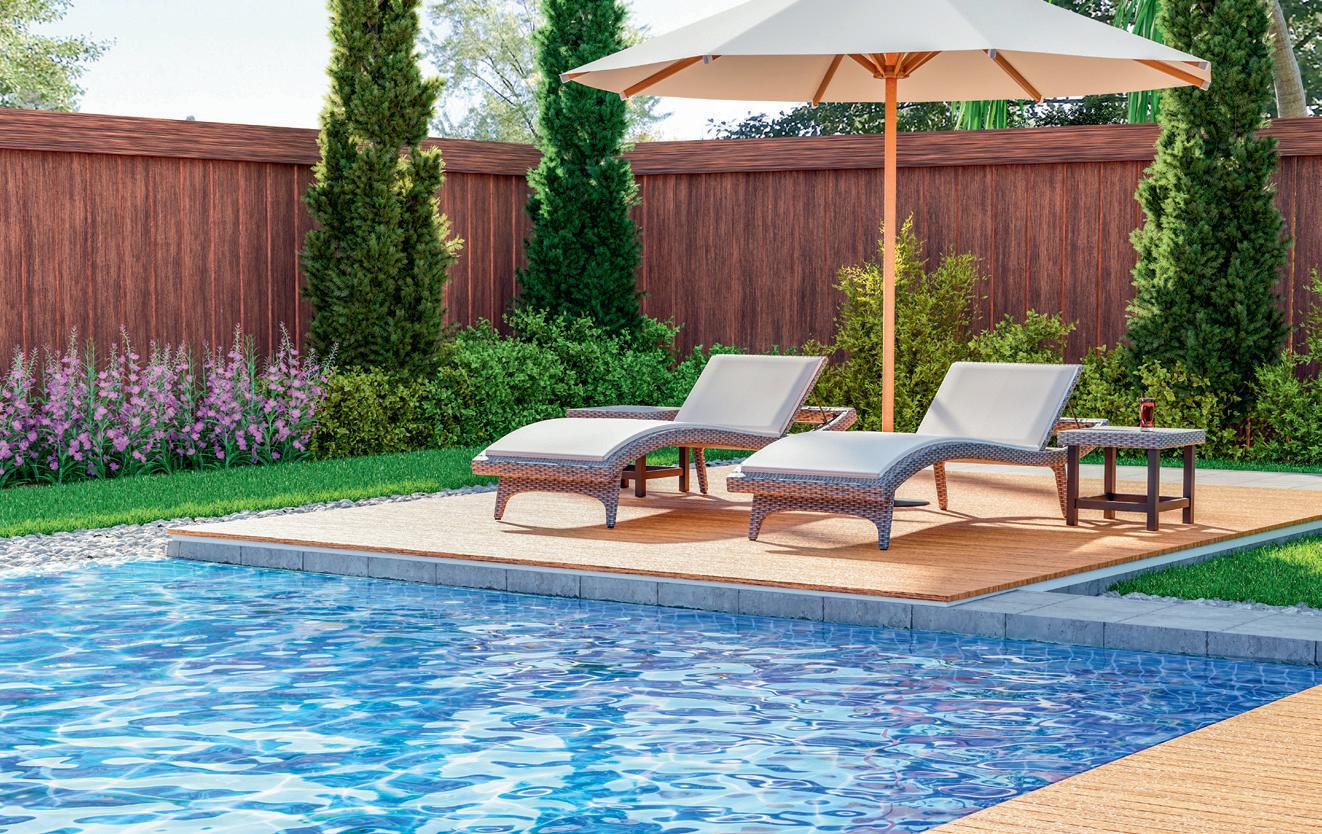
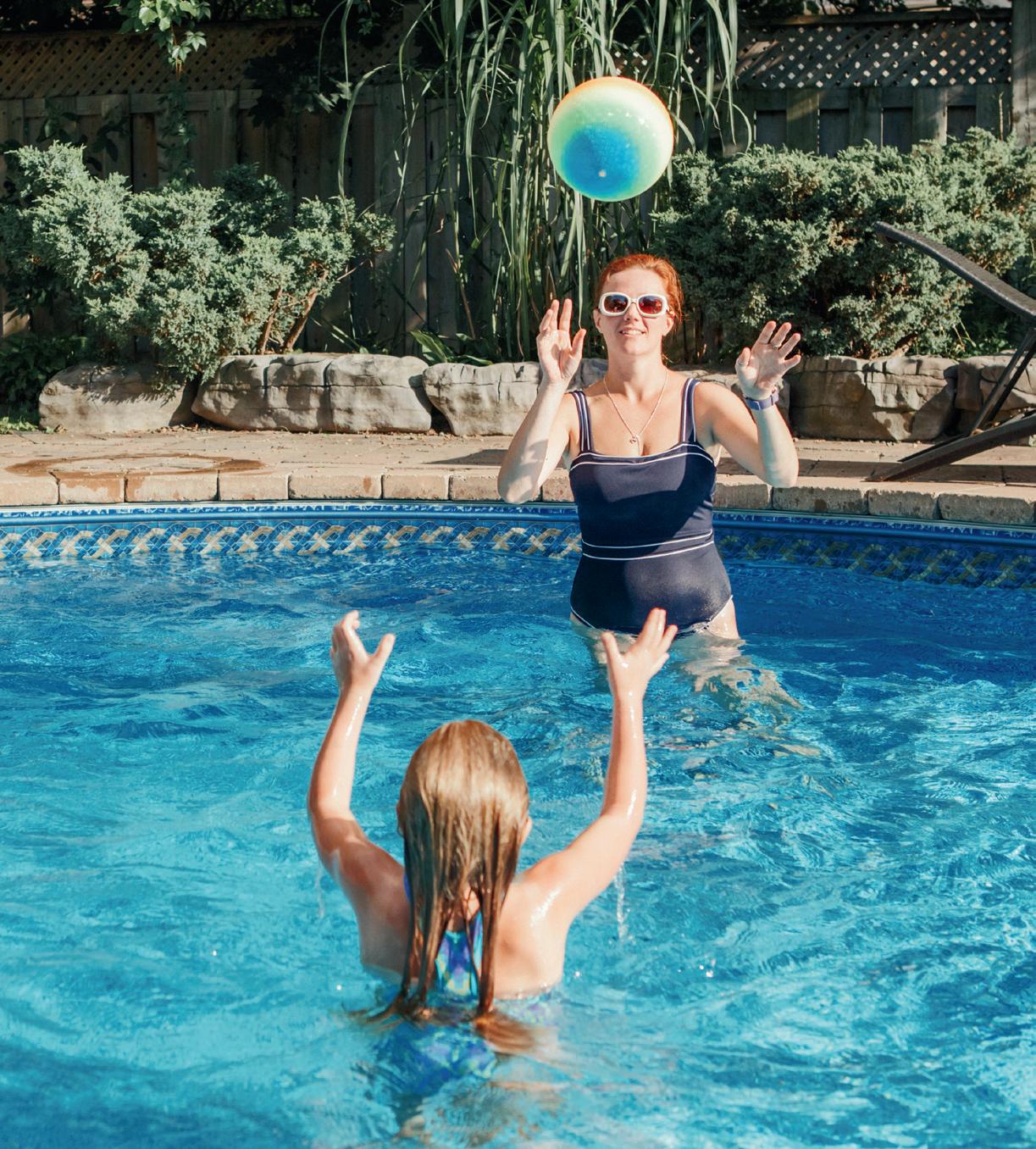
If you are looking to update and narrowing down the multitude of choices based on lifestyle, location and budget, don’t forget about the long-term implications. A cheaper initial choice may seem like a good idea, but costs can quickly add up if the maintenance requirement is high. And don’t forget the drain on your time — you’d be surprised how quickly six months can pass when it’s time to treat your deck again.
As with any building project, get as much information and advice as you can upfront. Think about how you want to use the space, who will be enjoying it with you and how long you expect to get from the installation. Every site is different, but the more you know upfront, the more likely you’ll be happy with the result.
Like most Aussies, you’ve probably spent your summer in and around the pool. But just because the seasons might be changing, your passion for the pool doesn’t have to. With a pool cover from Daisy, you can double your swimming season, double the use of your pool, and double the fun.
The fact is, pools lose their heat through the water surface. To retain the heat, reduce evaporation and keep unwanted debris out, an insulation barrier is required. Daisy’s specially designed and manufactured pool covers offer exactly that, warming and insulating your pool, extending your summer and providing a better swimming experience for you and your family. With a warm and leaf-free pool ready and waiting whenever you need it, there’s no more pre-swim
scooping required, just dive straight in — it’s that easy!
But the benefits of pool covers go beyond just comfort and convenience.
Did you know that a swimming pool can evaporate up to twice its volume every year? With each pool requiring tens of thousands of litres of water to fill, reducing evaporation will not only reduce water requirements but also your water bills. Perfect for the environmentally conscious, a Daisy pool cover saves on water, reduces the need for chemicals, and provides a natural way to heat pools all contributing to a better way of life. It’s all part of the official recognition by SPASA as a Climate Care Certified product.


Don’t be put off by pool upkeep, a Daisy pool cover
will do the hard work for you. Acting as a barrier, a pool cover keeps the leaves and debris out — a problem especially in autumn — reducing the workload on your pool cleaner and yourself by not having to constantly clean it out. Less scooping and more swimming, that’s what it’s all about!
When it comes to the cost of a pool cover, it’s
important to remember the return you’ll get on your investment. When you consider the reductions in water, energy, chemicals and time, the savings really start to stack up.
Delivering comfort, convenience and costsavings, the addition of a pool cover makes a lot of sense. As the seasons start to change, let a Daisy pool cover deliver the endless summer you’ve been dreaming of.
P: 1300 551 811
E: HELLO@DAISYPOOLCOVERS.COM.AU
W: WWW.DAISYPOOLCOVERS.COM.AU
Knowing the size of your pool and spa and how much water it holds is pretty useful information. It not only helps you determine the correct chemical dosage for maintenance and sanitisation, but also makes it easier to select accessories and equipment like pumps, cleaners and covers, where surface area or other measurements can guide you to the most suitable option.

Calculating the volume is easy, using the following formulas.
Three measurements apply for square or rectangular pools and spas: 1) width (W), 2) depth (D) and 3) average depth (ad).
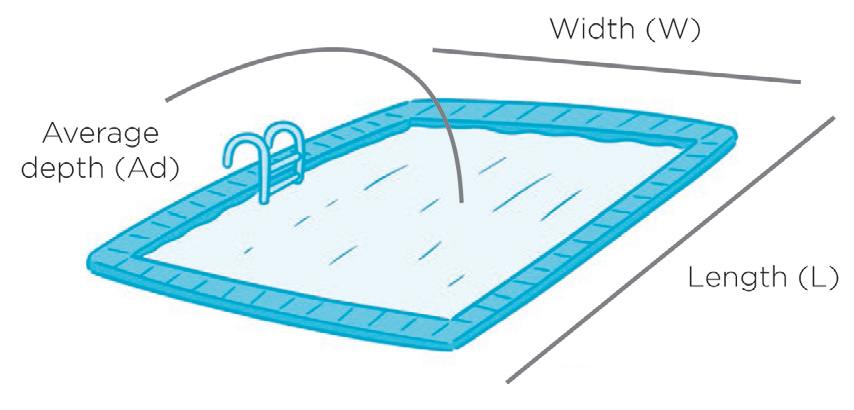
The formula to calculate volume:
W x D x ad x 1000 = volume in litres (L)
For a pool that is 9 m long and 4 m wide with a shallow end depth of 1.2 m and a deep end depth of 1.8 m:
9 x 4 x [(1.2 + 1.8) ÷ 2] x 1000 = 54,000 litres
There are two measurements that matter here: 1) the diameter (D) — the measurement from one side to the other; and 2) the average depth (ad), illustrated below.
The formula to calculate volume:
D x D x ad x 785 = volume in litres (L)
For a pool with a 6 m diameter, a shallow end depth of 1.2 m and a deep end depth of 1.8 m:
6 x 6 [(1.2 + 1.8) ÷ 2] x 785 = 42,390 litres
Oval pools will have a long diameter and a short diameter, but the formula remains the same.

These can be tricky to measure — if possible, check with the builder or installer. Otherwise, you can calculate using the above formulas and substituting averages for the diameter, width and length measurements based on the nearest approximation.
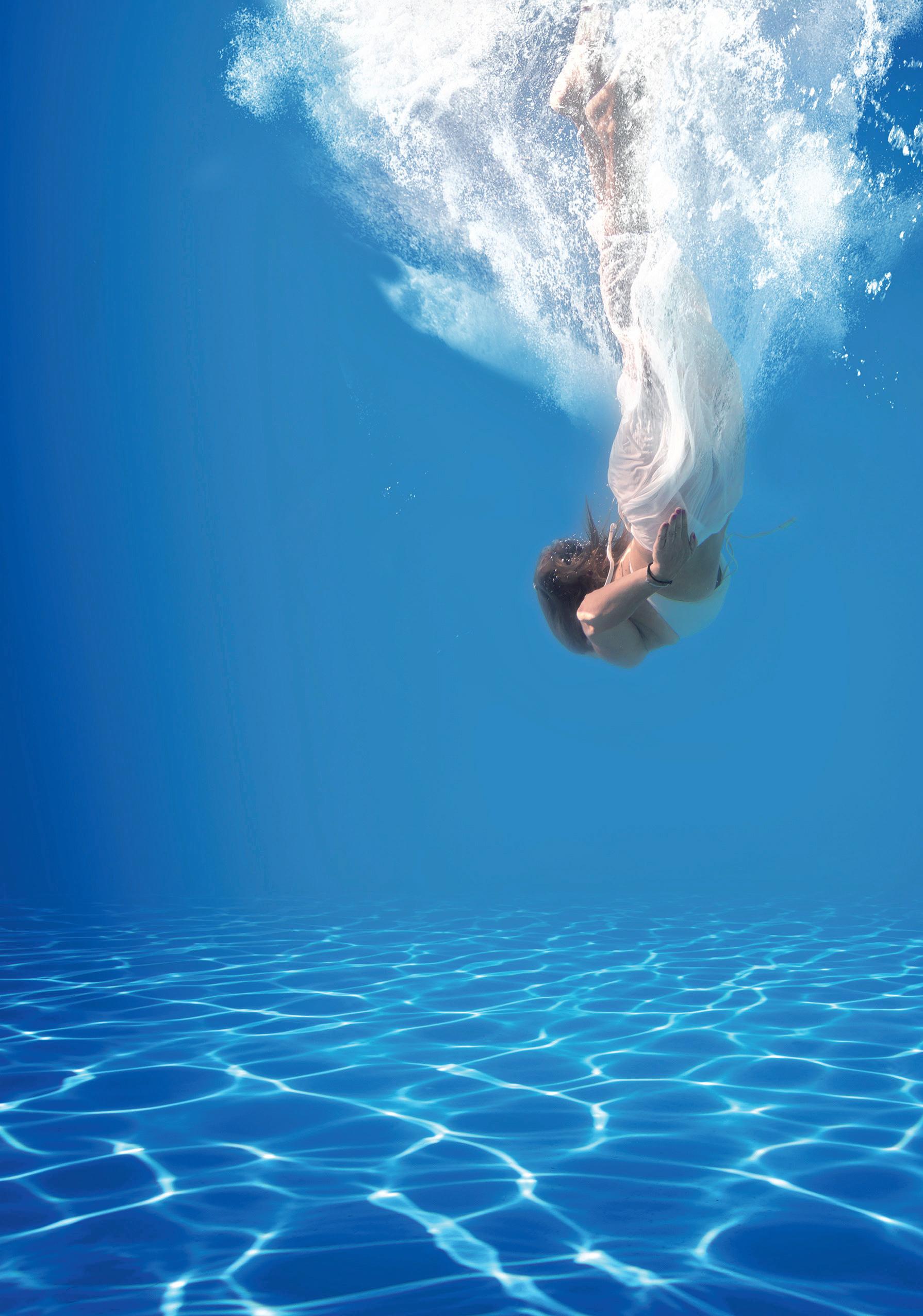
Do you own a saltwater or manually chlorine dosed pool and have been considering converting to a MagnaPool ®? It is possible to experience the difference with just a few small changes performed by an authorised MagnaPool agent.
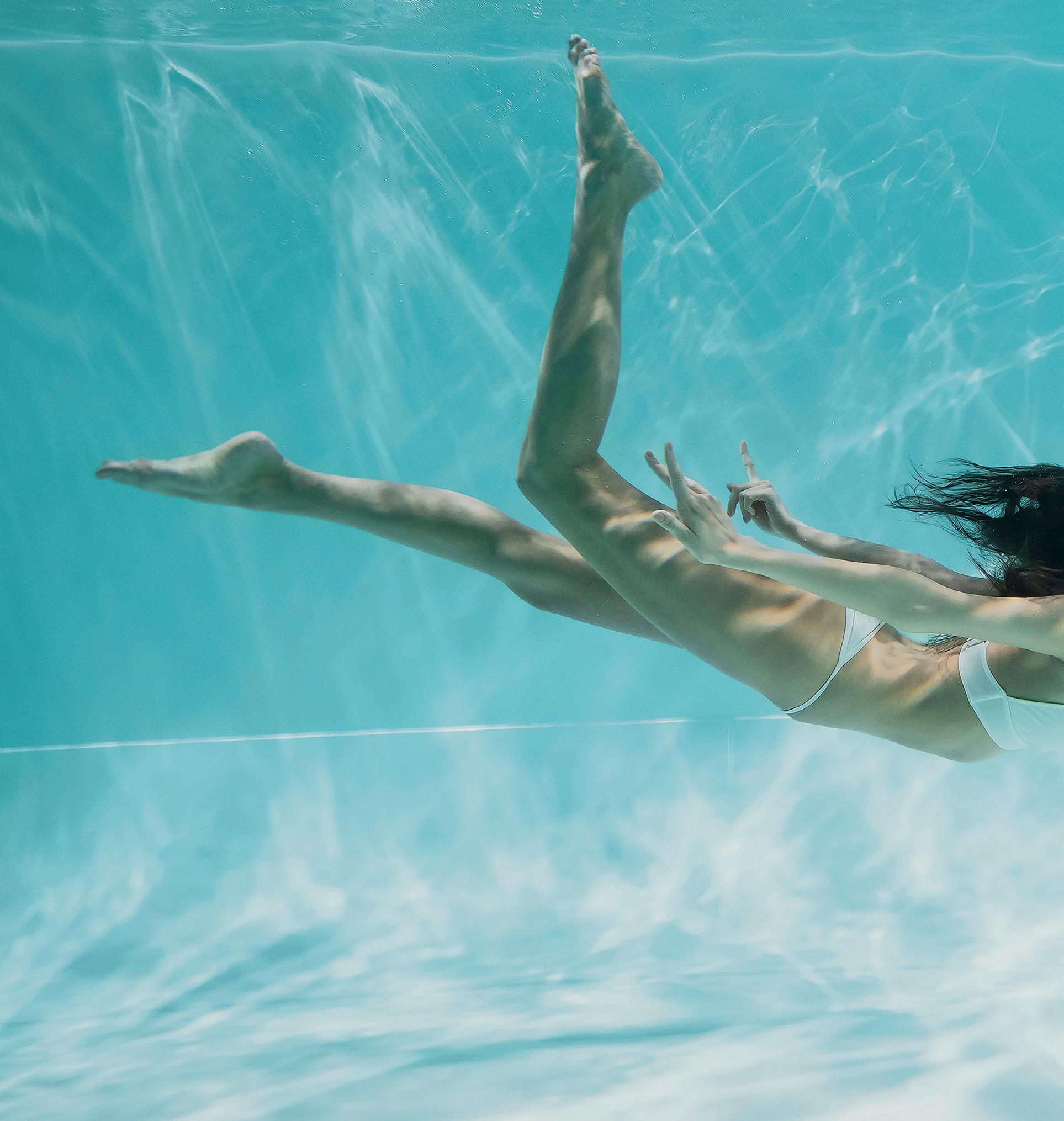
Firstly, it is highly recommended that you carry out a full water
analysis prior to converting your pool to ensure everything goes smoothly. Also it is recommended to use a media filter filled with glass for a MagnaPool to ensure optimum performance. However, if you choose to use a cartridge filter you just need to ensure it is an oversized model to help prevent excessive cleaning due to the exceptional
flocculent properties of MagnaPool minerals. The MagnaPool system consists of the products listed below:
• The Hydroxinator & Reverse Polarity
Electrolytic Cell
• Glass Filtration Media
• MagnaPool Minerals
The benefits of a MagnaPool are optimised when the complete system is installed. The conversion
from a manually dosed chlorine pool or saltwater pool to a MagnaPool is an easy process that can be summarised in five easy steps.
Step One: The Hydroxinator is installed in a suitable spot and connected to the electrolytic cell on the plumbing line. Any reputable pool care professional can do this
for you and is relatively inexpensive.
Step Two: Ensure you have the preferred glass filter installed properly. If you already have a media filter (thermoplastic or fibreglass) with sand in it, you will need to change over to glass media. Removing the sand from a filter will require a pool care specialist to assist you. Once the filter is empty of
sand, the glass media can be loaded. Coarse glass is used on the bottom of the filter and the rest is filled with fine glass. This combination of coarse and fine glass allows for the best filtration and backwashing capabilities. If you have a small cartridge filter in place it may be necessary to install an oversized model or you may find that you will have
to constantly clean the filter elements.
Step Three: Obtain a salinity and/or TDS test to determine how many bags of minerals you will need to add to your pool. Your pool shop or pool professional can quickly and easily do this for you. The lower the salinity the better as it will give you the true MagnaPool feeling straight away. If your current salinity is higher, it will mean you can either remove some water via backwashing over a few days and replace the lost water with fresh water, or just gradually top up your pool with minerals as you need to. The latter method, however, may not give the full impact of the MagnaPool feeling, but will happen over time as you replace your salt
with MagnaPool minerals. Based upon the salinity measurements from your water test, you’ll simply need to add in the appropriate amount of minerals and switch on your filtration equipment.
Step Four: Once you’ve added the right amount of MagnaPool minerals, let the system run for at least 24 hours non-stop to get proper circulation and dilution happening. You may notice some foaming appear during this start-up phase, this is just part of the process.
Step Five: Jump in and enjoy your new MagnaPool.
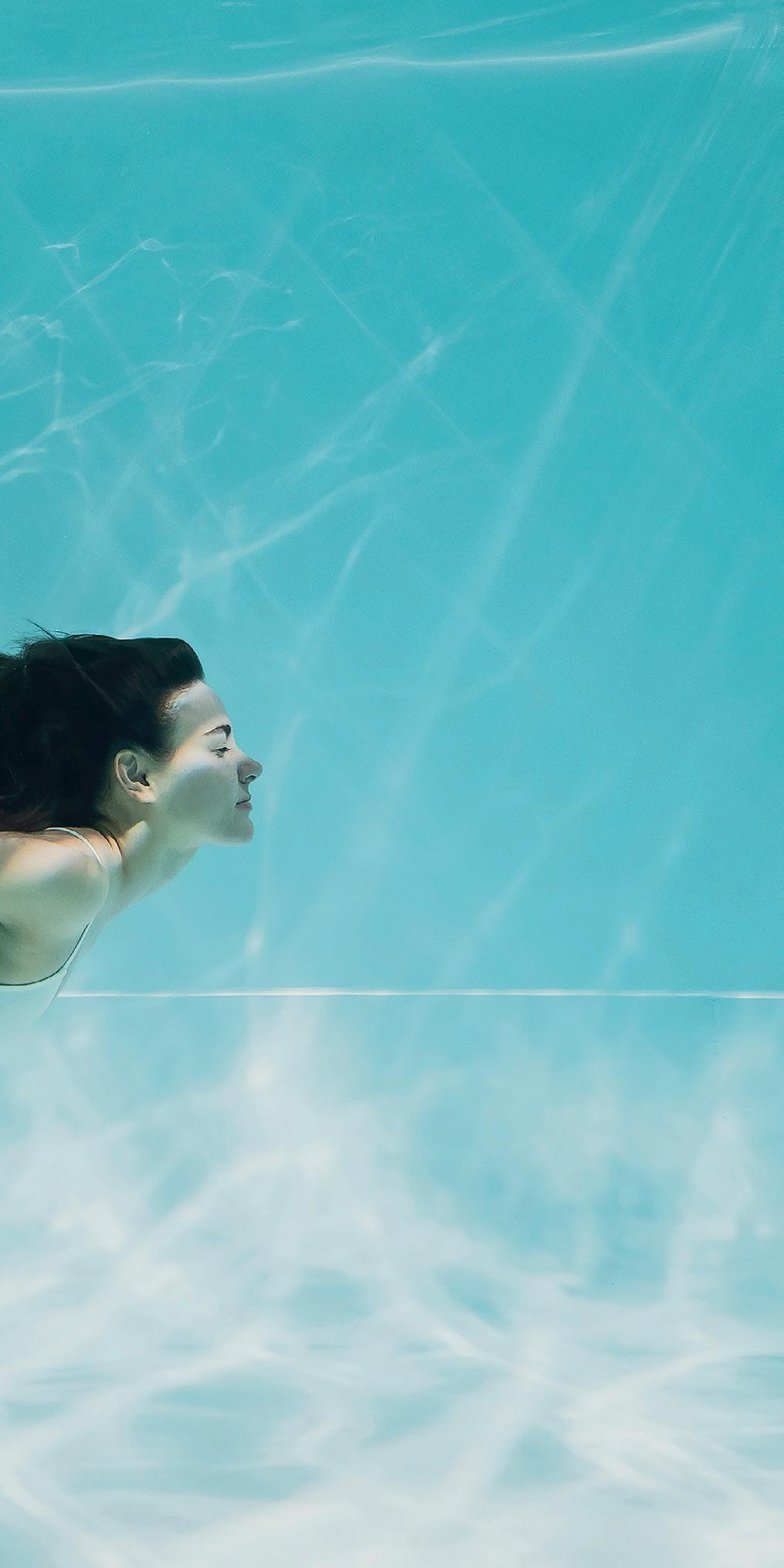
Visit MAGNAPOOL. COM.AU to find your nearest authorised MagnaPool Dealer who can assist you with equipment and set up.
P: 1300 763 021
W: WWW.MAGNAPOOL.COM

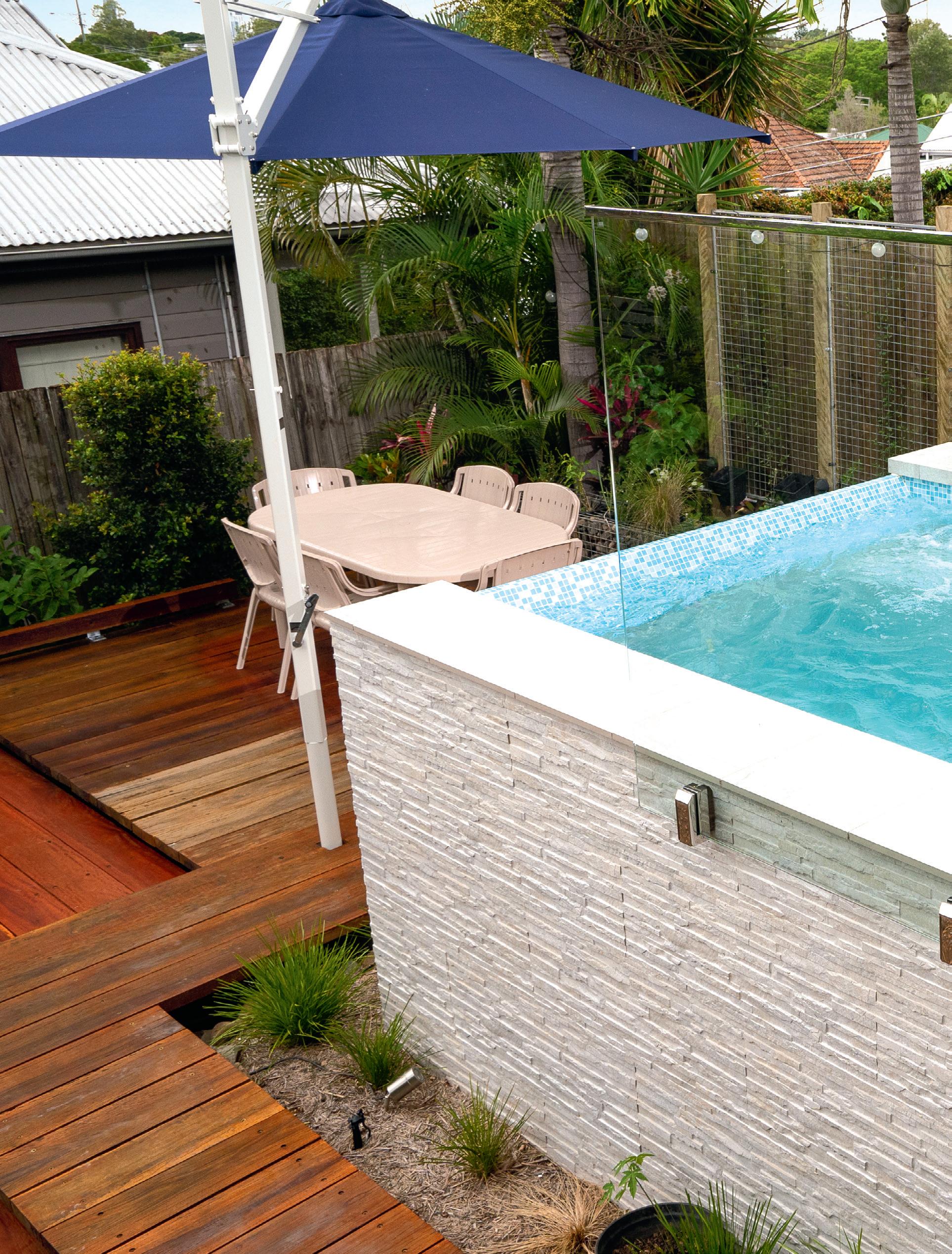
At Queensland Family Pools we construct high quality, one-of-a-kind, custom in-ground concrete swimming pools at a great price. With over 70 years’ combined experience, we know everything there is to know about building beautiful swimming pools and spas, which is why we’ve been recognised as SPASA Australia’s Pool Builder of the Year four times.
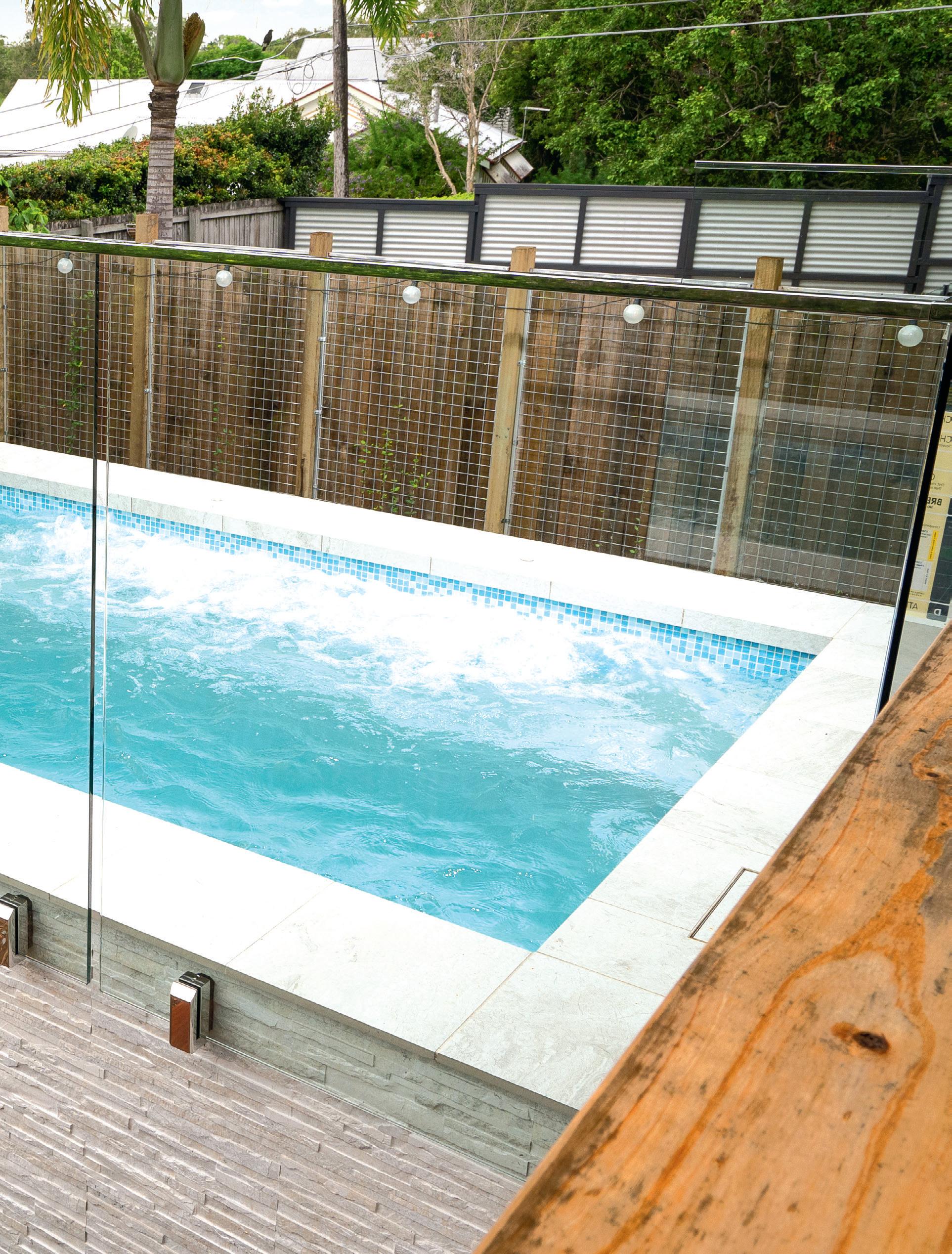
This multi-purpose spa and plunge pool is a perfect solution in this small innercity backyard. The simple and stylish above ground plunge spa pool is surrounded by porcelain coping tiles and extends perfectly from the outdoor entertaining area, allowing the owner to enjoy the spectacular sunsets. The use of varied mosaic tile for the false edge of the pool creates a unique line that complements the natural stone.
P: 07 3216 5004
E: SALES@QUEENSLANDFAMILYPOOLS.COM.AU
W: WWW.QUEENSLANDFAMILYPOOLS.COM.AU

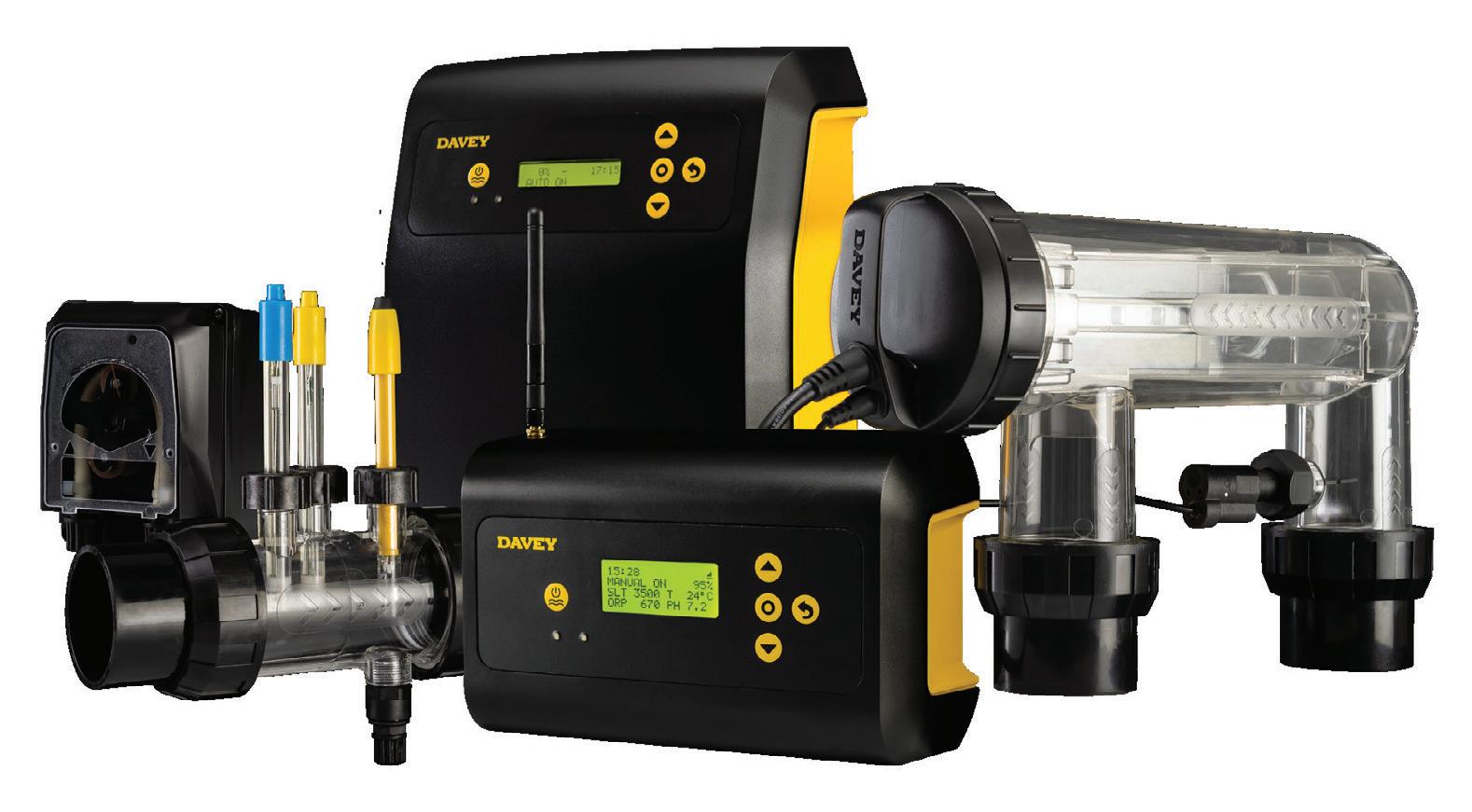


WATER FEATURES BRING THAT LITTLE SOMETHING EXTRA TO ANY POOL, WHETHER ADDING A TOUCH OF DRAMA OR CREATING A SOOTHING SPACE FOR RELAXATION.

These designs come in a range of sizes and styles that can be fitted in straight or curved lines to suit your requirements. As the names imply, they feature a curtain or cascade of rushing water that automatically becomes the focal point of the pool, particularly if illuminated at night-time.
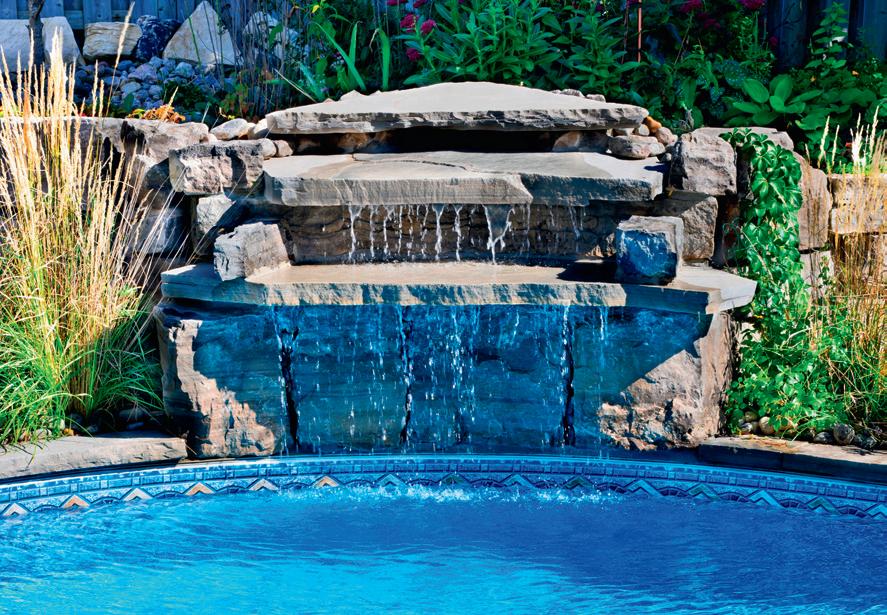
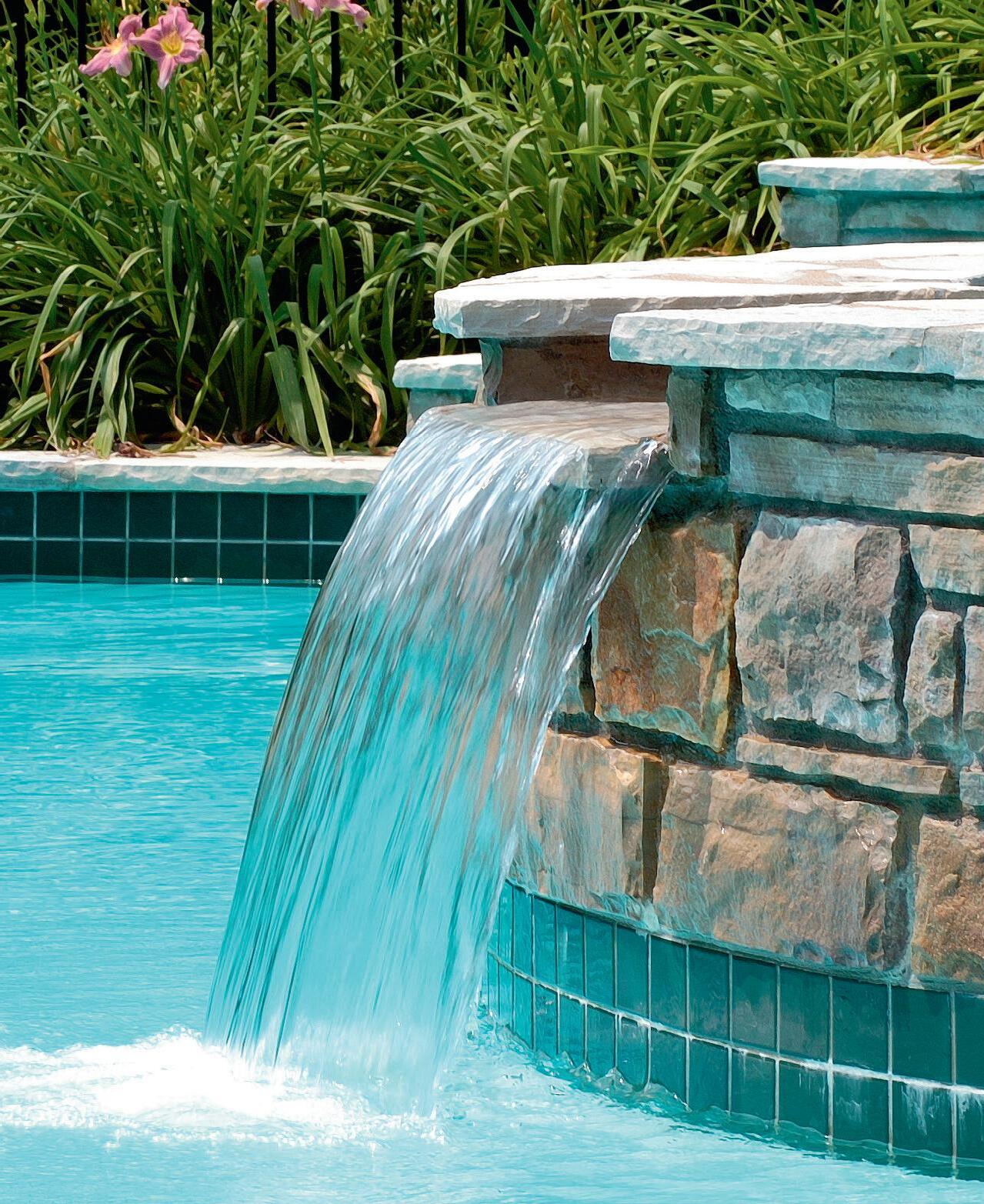
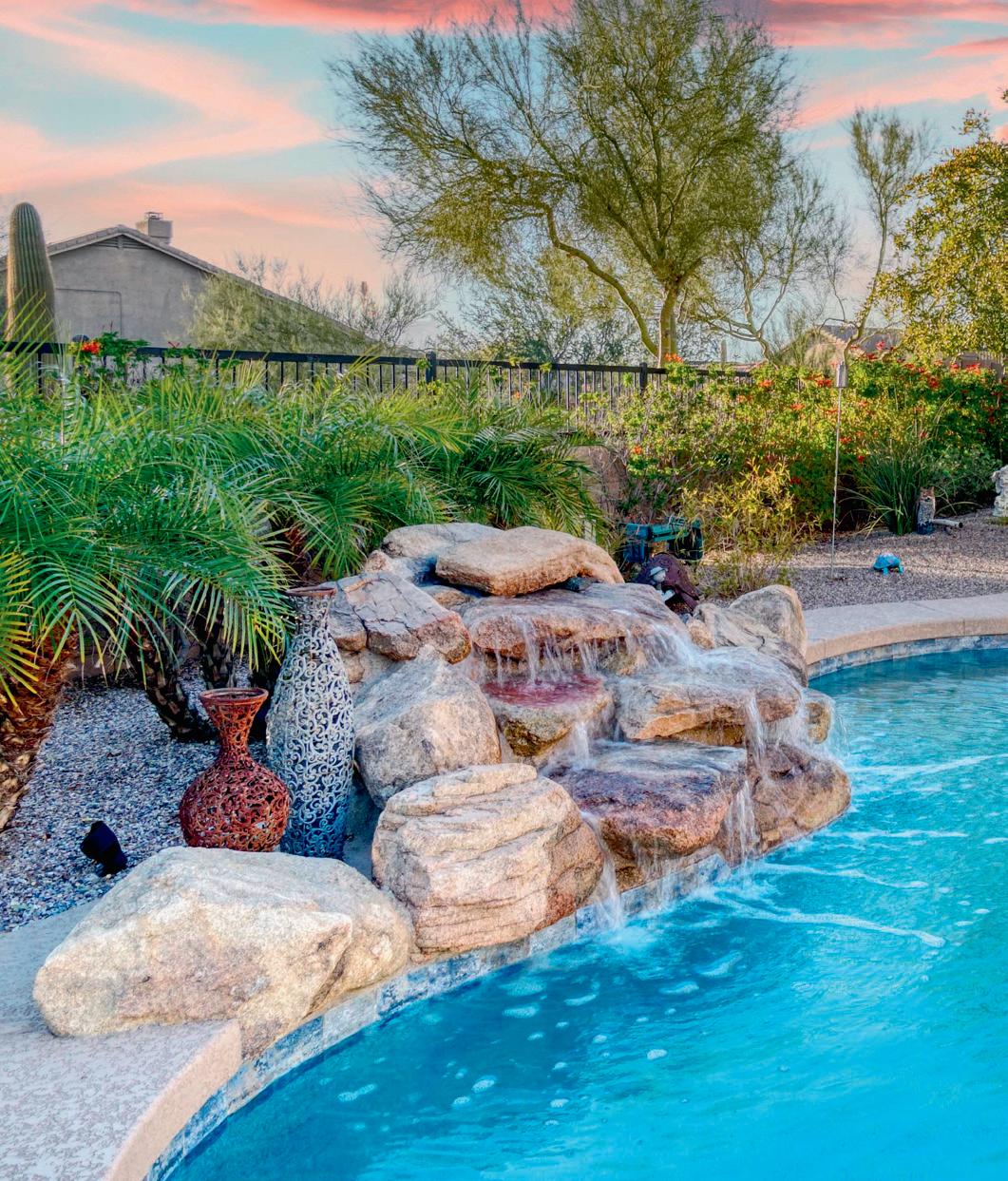
Rain designs are intended to mimic the sound of rainfall, offering a relaxing soundscape and adding another dimension to your outdoor oasis. They will give varying effects at different heights but as a rule of thumb, the greater the height, the noisier they are.
Delivering the drama of a waterfall means moving a fair amount of water, so you need to ensure your pump is up to the task or if you can incorporate additional equipment and that you’ve factored in any additional running costs when it comes to energy use.
“
Water jets are usually single arcs of water positioned on the pool deck that shoot into the pool. They can be lit up at night to deliver a bit of added interest and help set the mood for a poolside party.
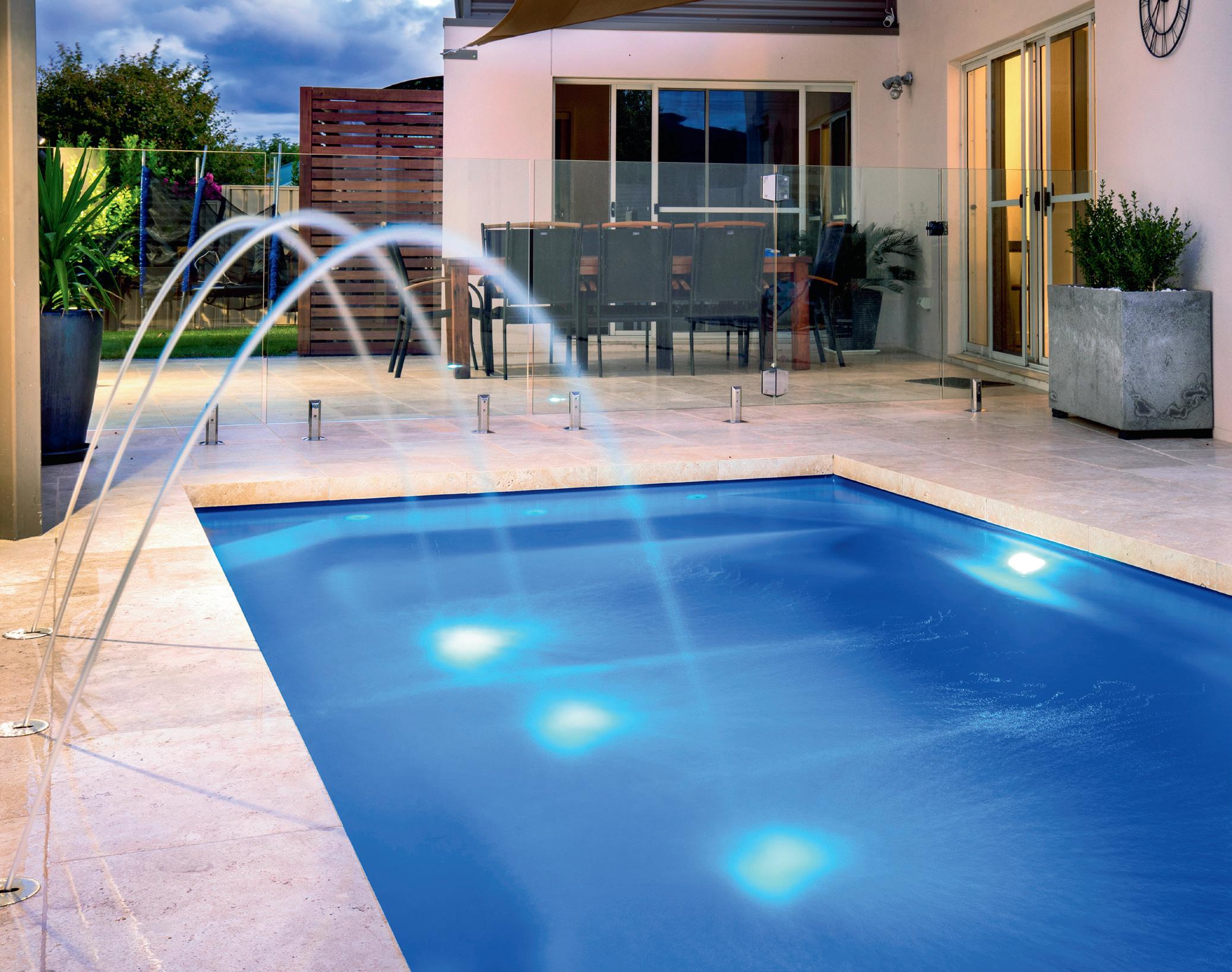
Pool gushers and bubblers are usually installed in shallow areas including steps, sun shelves, ledges, benches or beach entries. They project water upward for an attractive effect that creates visual interest.
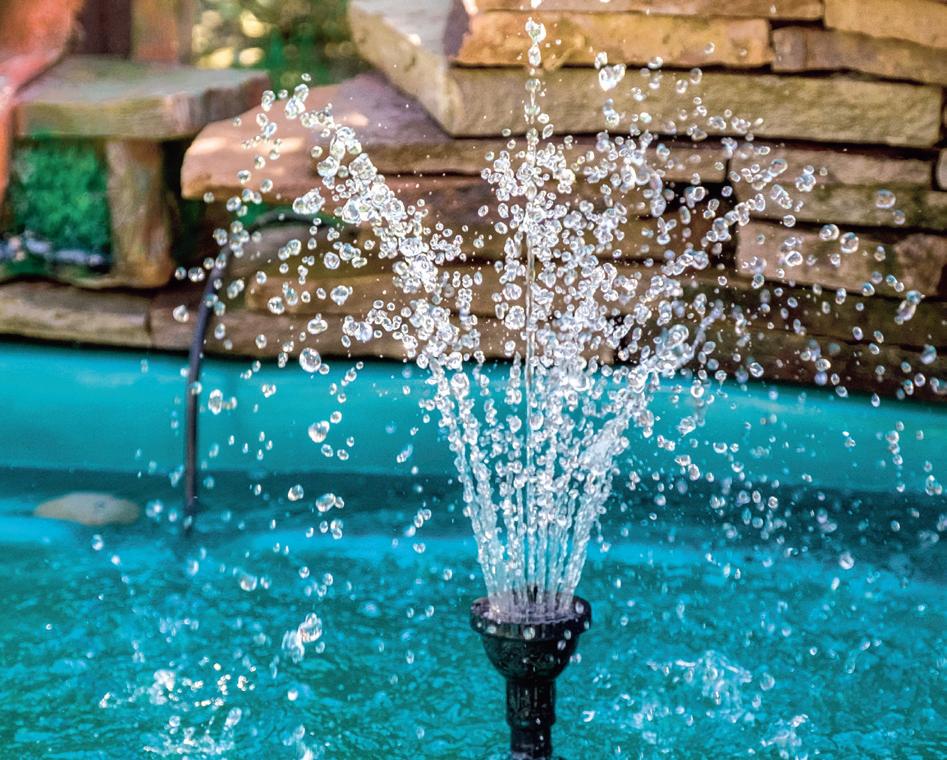
Spillways are a fantastic way to link two elements, like a pool and spa, connecting them visually while still ensuring they operate as distinctly separate areas. These are sometimes referred to as dam wall designs and are a great way to take a dull functional design element and give it an huge aesthetic push.
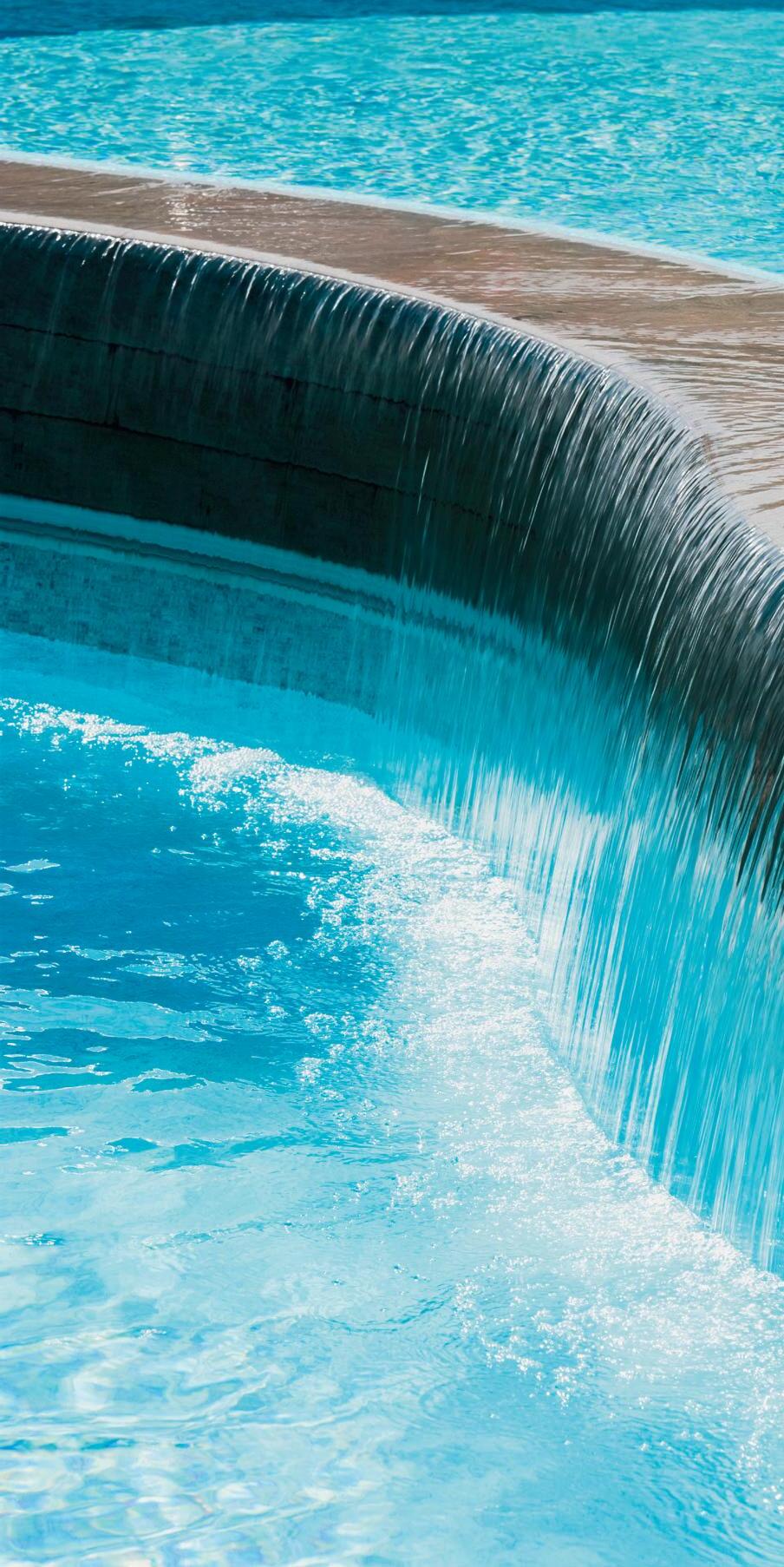

Take
These options deliver narrow projections of water — more than a jet, but less than a curtain. They can be arranged in multiples with any space variation to create a commanding water feature that catches both the eye and the ear. The more concentrated flow makes for a noisier water feature than other types.
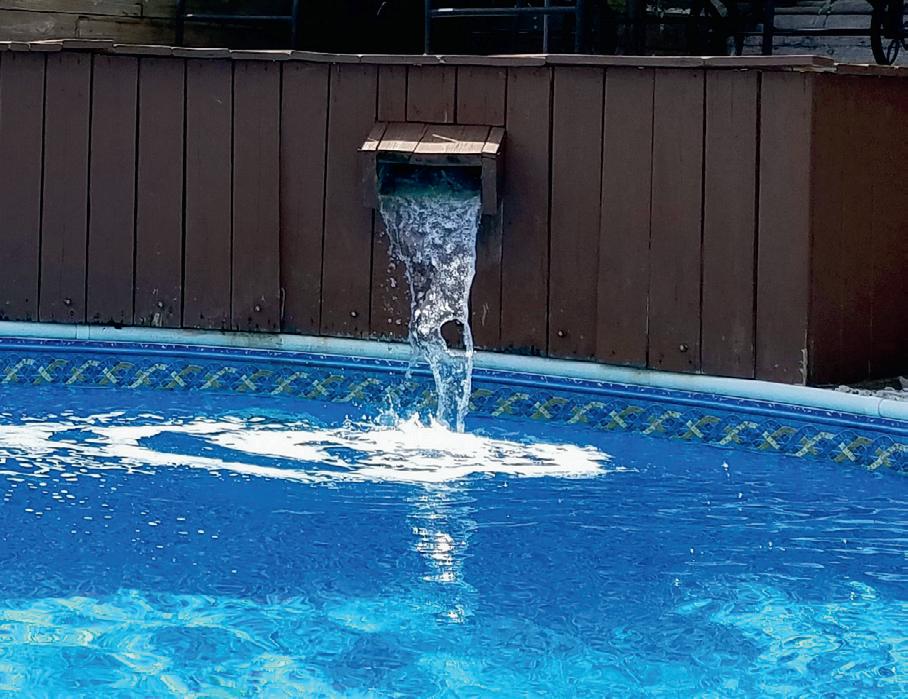
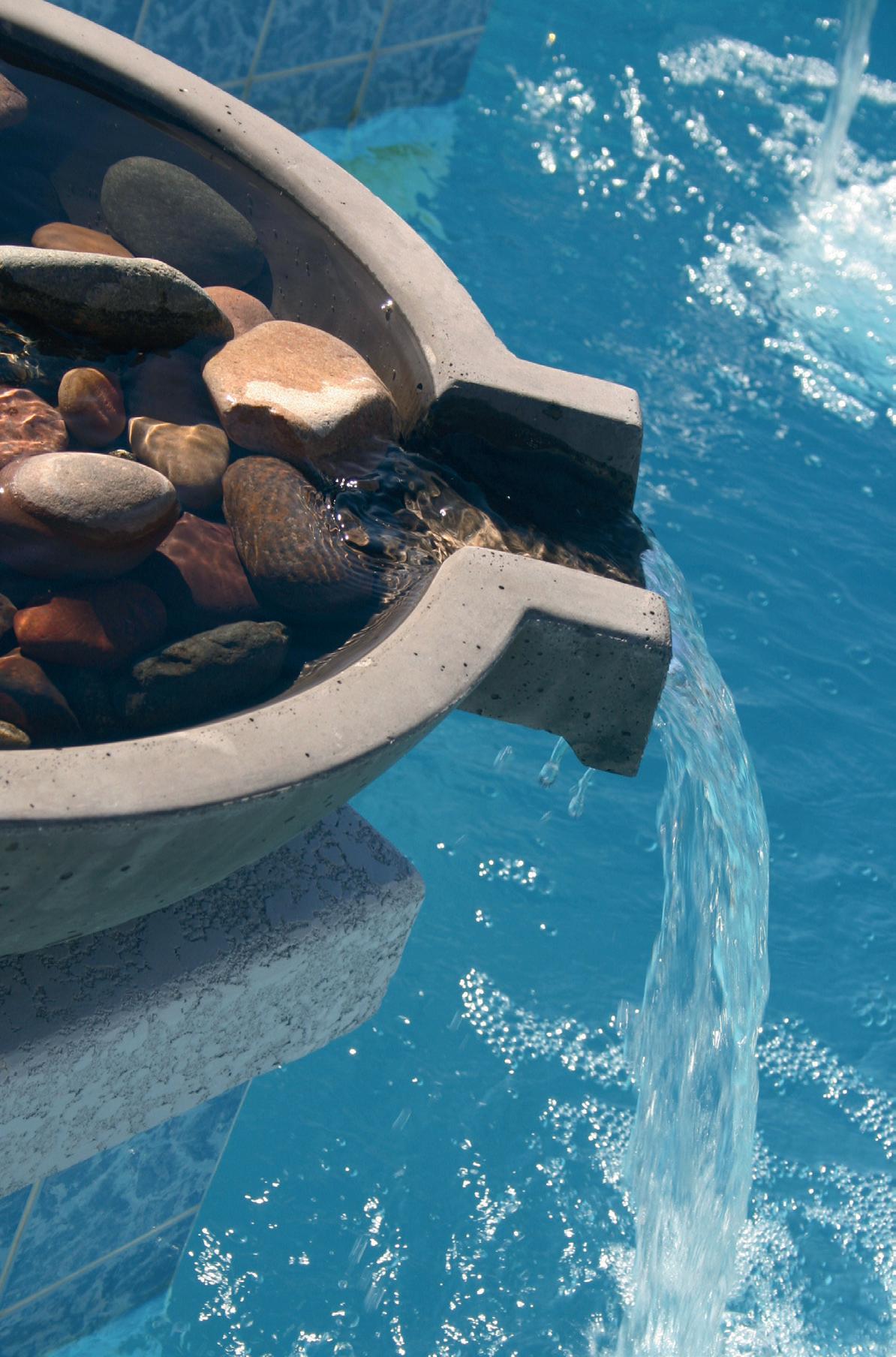
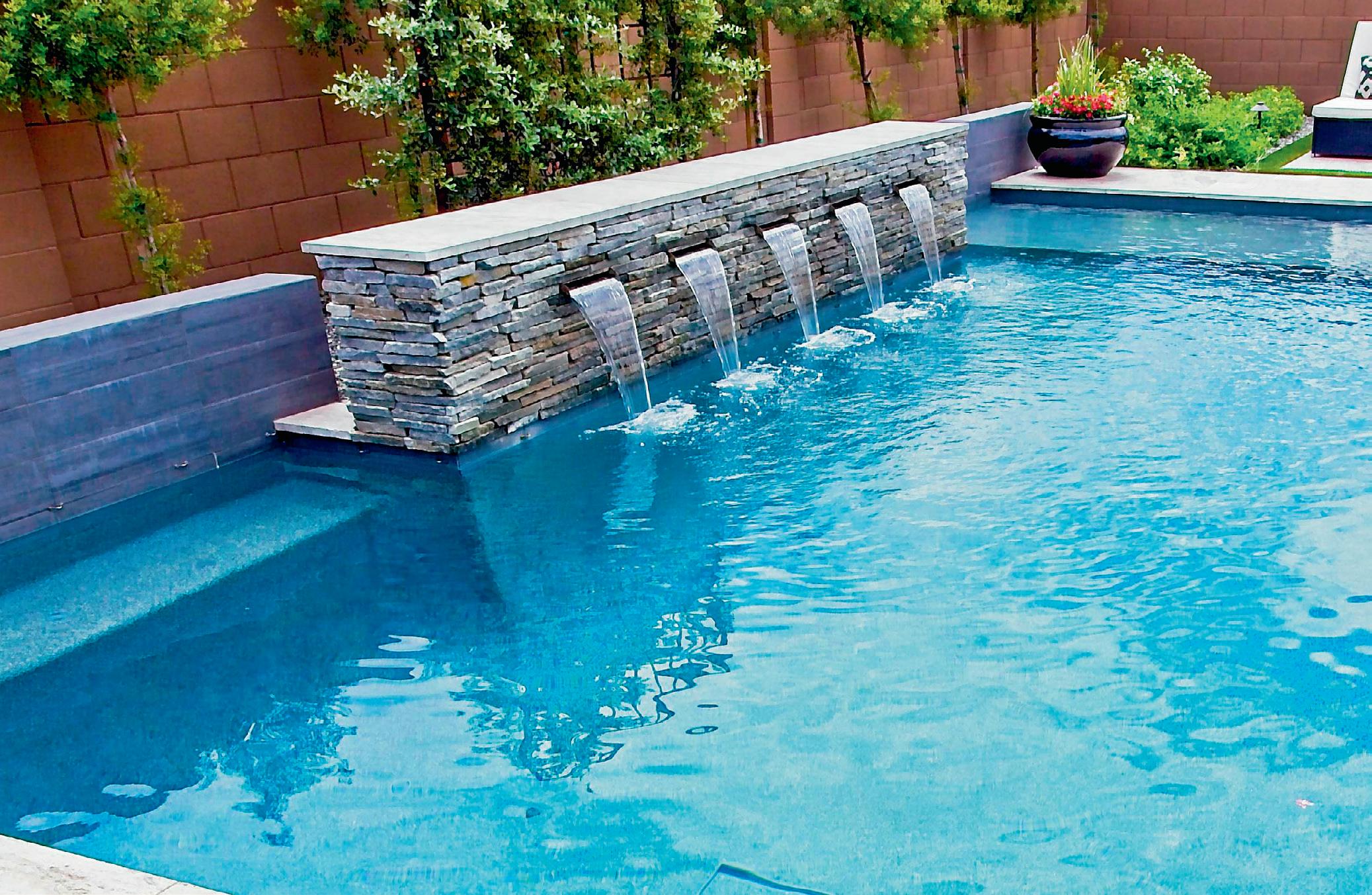
a dull functional design element and give it a huge aesthetic push.
A perfect retrofit option, there are virtually no design limits to water bowls and pots. They work best when positioned higher than the pool edge surface – on a raised wall for instance — which gives the water a more spectacular fall line and adds to the visual appeal.
The look and feel of your home and existing outdoor area will help narrow down the options for suitable water features — there’s no point dreaming of a rustic, natural-looking waterfall and sandstone rockwork if the rest of your design elements are streamlined, contemporary and clean.
Think about the noise levels. You may find the constant sound of rushing water to be more thundering
than calming if you aren’t prepared for it… and no one wants a water feature that’s too noisy to turn on. You should also be aware that some options may increase evaporation during warmer months, but it shouldn’t be too noticeable overall. On the other side of the maintenance coin, anything that moves water through the pool spells good things for filtration, so your water feature will earn its keep.
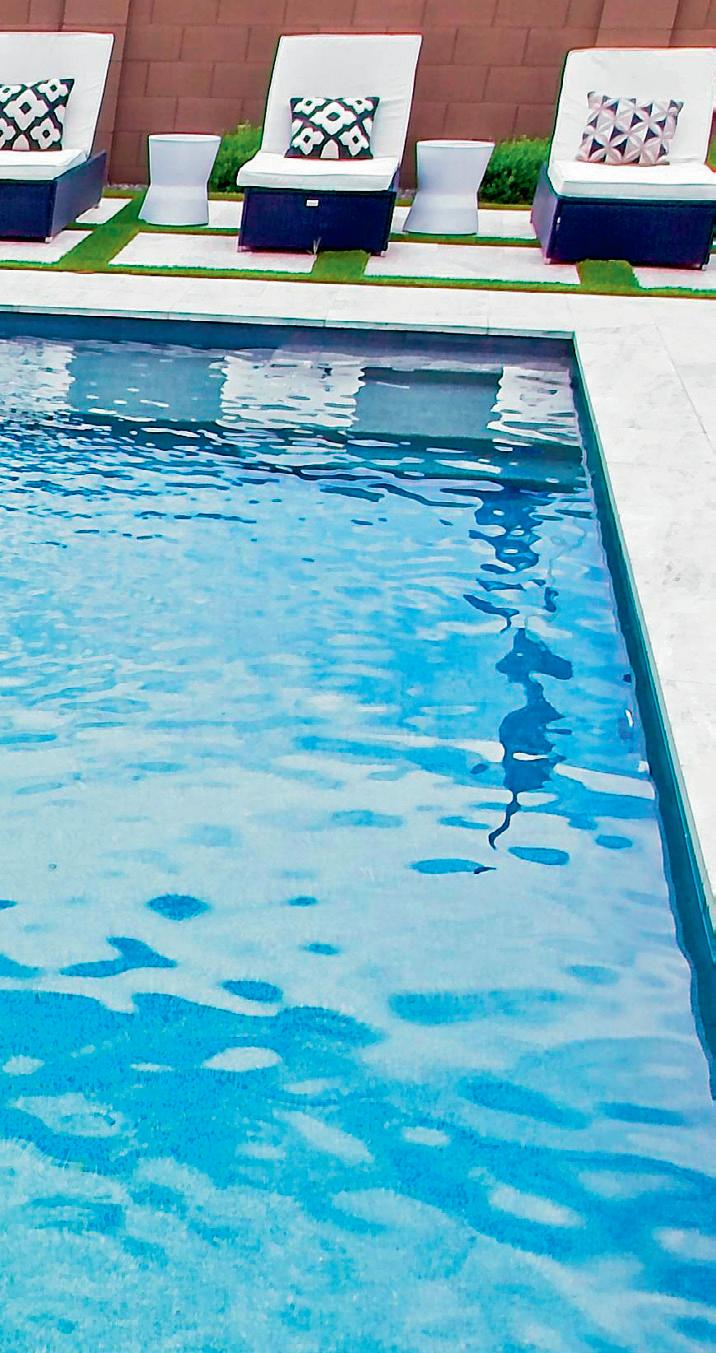
As with any pool project, speak to a trusted pool professional before you embark on anything, ensuring that design and installation is a practical option in terms of your site and existing equipment and systems, and delivering the best choice for your needs.

Every pool owner aims to have a sparkling clean pool. Not only are good looks important, but sparkling clean pool water is equally as important for the safety, health and mechanical integrity of the pool and its equipment. Getting that beautiful pool water involves dealing with the two major areas, which must work together:
Filtration
This is the process of removing particles from the water. Most of these particles are individually smaller than the human eye can see, but in
volume will cloud the water. Depending on the filtration system and media used the particles will usually be filtered down to 20 micron or less. The smaller the micron rating the better the pool water will look.
This is vital to manage scaling, discolouration, comfort, pathogen levels and effectiveness of the chemicals in the water. This is often referred to as chemical balance. For most pools, the highest priority factors to maintain for chemical balance are:
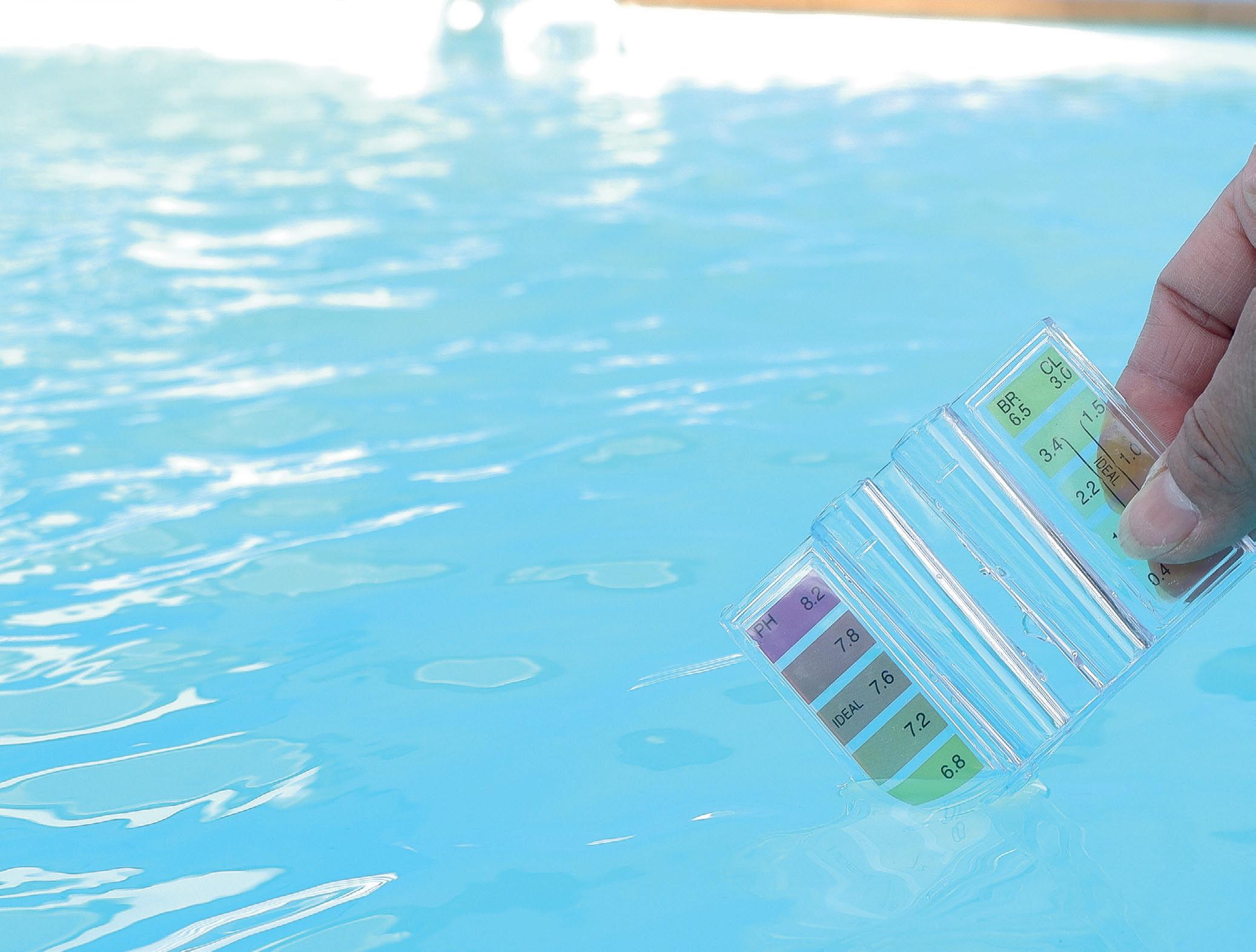
Chlorine : This is the primary method of addressing potential pathogens in the pool water. Traditional chlorinated pools, salt water pools and magnesium pools all use chlorine as the sanitiser. Too low will allow pathogens to breed and too high will do damage to swimmers and pool equipment.
• Chlorine 1.5–3ppm pH : The pH levels are vital in ensuring the chemicals in the water can do their job, plus swimmers and pool equipment are protected.
Luckily, the best pH level is around the same level as the human body (pH 7.4). Due to the actions of the sanitiser pool water pH will rise normally over time.
• pH 7.2–7.6
Total Alkalinity: This is a measure of the ability of the pool water to maintain a desirable pH when acid is added to the pool water. Too low can cause damage to pool equipment. Too high can create issues dropping pH and be visible as cloudy water.
• Total Alkalinity 80–150ppm
Calcium Hardness : Maintaining calcium hardness is important to protect pool equipment as well as ensuring bather comfort. Too low and pool surfaces can suffer. Too high will result in excessive scale build up on pool surfaces and equipment. High levels of calcium hardness will mean the pool water feels hard for swimmers.
• Calcium Hardness — Concrete pools: 200–275ppm and other pool surfaces 100–125ppm
Cyanuric Acid (stabiliser): When chlorinated water is
exposed to UV light, the chlorine content in the water is reduced very quickly. Adding an effective range of cyanuric acid or stabiliser will help retain the chlorine in pool water. Too low and chlorine levels will drop too quickly. Too high and algae growth in the pool may be more likely.
• Cyanuric Acid (stabiliser) 25–50ppm but if you are using an ORP controller
15–25ppm
Each element plays a crucial role in maintaining the health of your pool, so if one of them slips out of
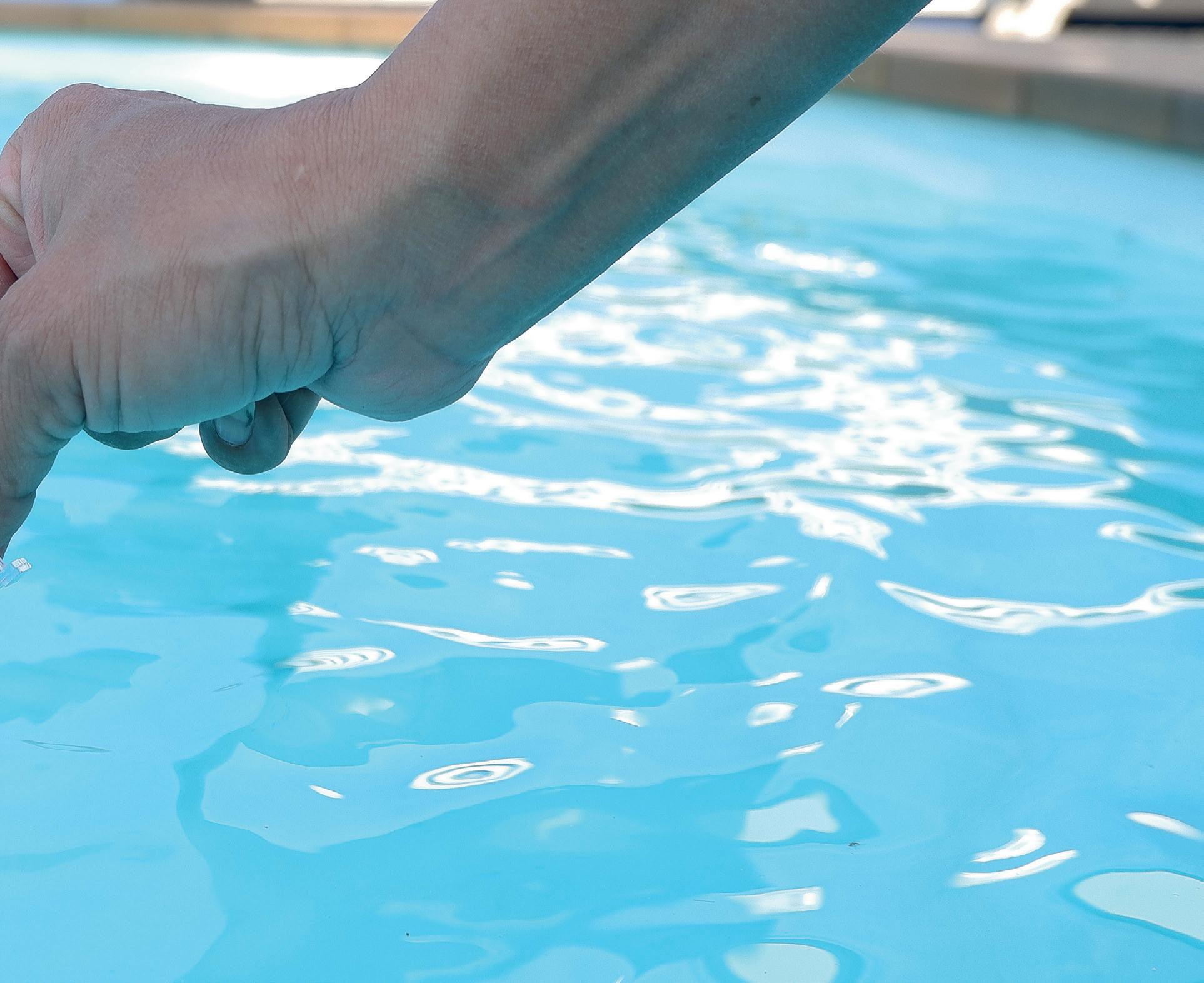
range then the others will be affected also.
The key to having a safe and healthy pool as well as protecting the pool equipment is pool water balance. How can Davey help you achieve this?
The new Davey Chloromatic Lifeguard can make balancing your pool chemistry levels
easier than ever before. Automated pH and ORP testing and dosing, along with state-of-the-art remote control, monitoring and notifications, means no more surprises when you’re ready to swim. To find out more or to locate your nearest stockist, visit: www. daveywater.com/au/product/ chloromatic-lifeguard.
P: 1300 2 DAVEY
Like everything else, pool ownership involves a fair bit of tech these days, and it might not always run smoothly. There’s often a simple solution to what looks like a complex problem and that’s where we can help. Before you tear your hair out, we’ll run through some common issues, possible causes and potential fixes for pool equipment problems. Today’s tech troubleshooting topic is… Pool Pumps and Filters.
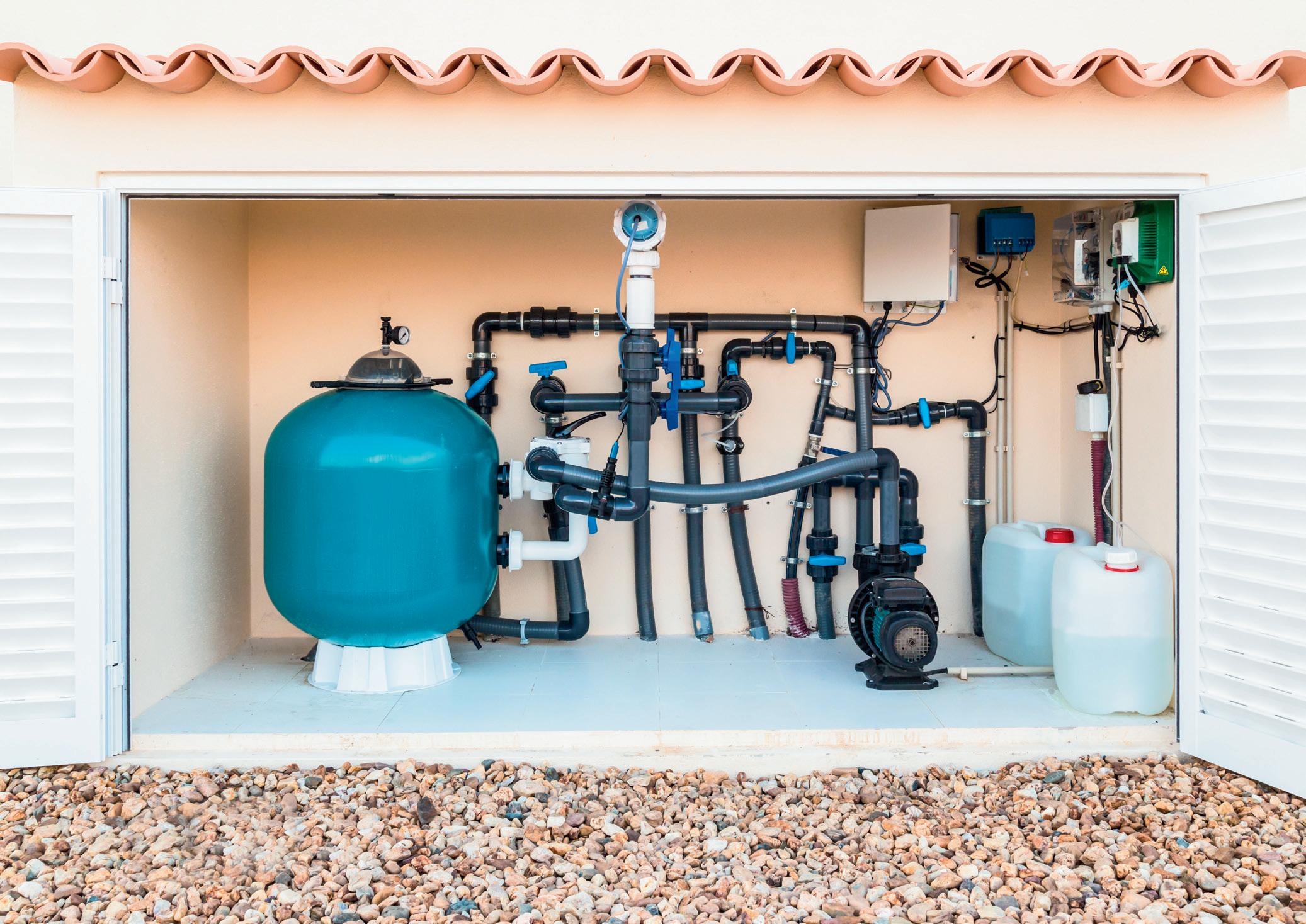
No power. Plug in or turn on power.
The bearings may have seized if the pump has not been run for a month or more.
Pump won’t start up
Thermal overload switch may have turned off and there is no water in the pump.
Pump is noisy
Take pump to your pool shop for bearing replacement.
Check the for reason for lack of water — eg, is the pool water level too low or has the pump lid O-ring perished, allowing air to enter? Wait five minutes, push the button on the pump and then turn pump on.
The impellor is jammed. Take pump to your pool shop for cleaning. Time clock faulty. Replace.
Bearings worn.
Pump lid O-ring is perished or lacking silicone grease.
Pump basket does not fill with water
Filter pressure rises rapidly giving a short time between cleans
Poor filtration in a salt pool
Take pump to your pool shop to replace bearings.
Grease or replace O-ring.
Pump basket full of leaves. Clean the pump basket.
The impellor is jammed. Take pump to your pool shop to be cleaned.
Air leak in suction line. Take pump to your pool shop for inspection and advice.
Sand or cartridge is old. Clean sand or cartridge with a proprietary brand filter cleaner. Replace sand that is more than five years old. Replace ‘feathery’ filter cartridges.
Sand or cartridge is scaled up. Clean with proprietary brand filter cleaner.
Not enough sand in filter. Replace all the sand.
Reduced water flow. Check for air leaks, clean sand with proprietary brand filter cleaner and clean baskets.
Pump running time too short. Increase running time to eight hours a day.
Air in filter. Open air release valve (if fitted) until water comes out.
Channels through sand — a sign the sand is probably more than five years old.
Sand is returning to pool
Poor filtration in a system that uses cartridges
Use filter aid or ideally replace sand.
Dead algae in the pool. Dead algae too fine for the sand or cartridge to filter out. Use proprietary brand clarifier or filter aid.
The filter is too small. Replace.
The skimmer basket or pump basket is full of leaves. Empty and clean.
Faulty multiport valve. Call service technician. Broken laterals in the filter. Call service technician.
The cartridge dirty, possibly coated in scale and body fats. Clean cartridge using a proprietary brand filter cleaner.
Physical damage including tears, holes or cracks. Replace the cartridge.
Cartridge has reached the end of its service life. Replace the cartridge.

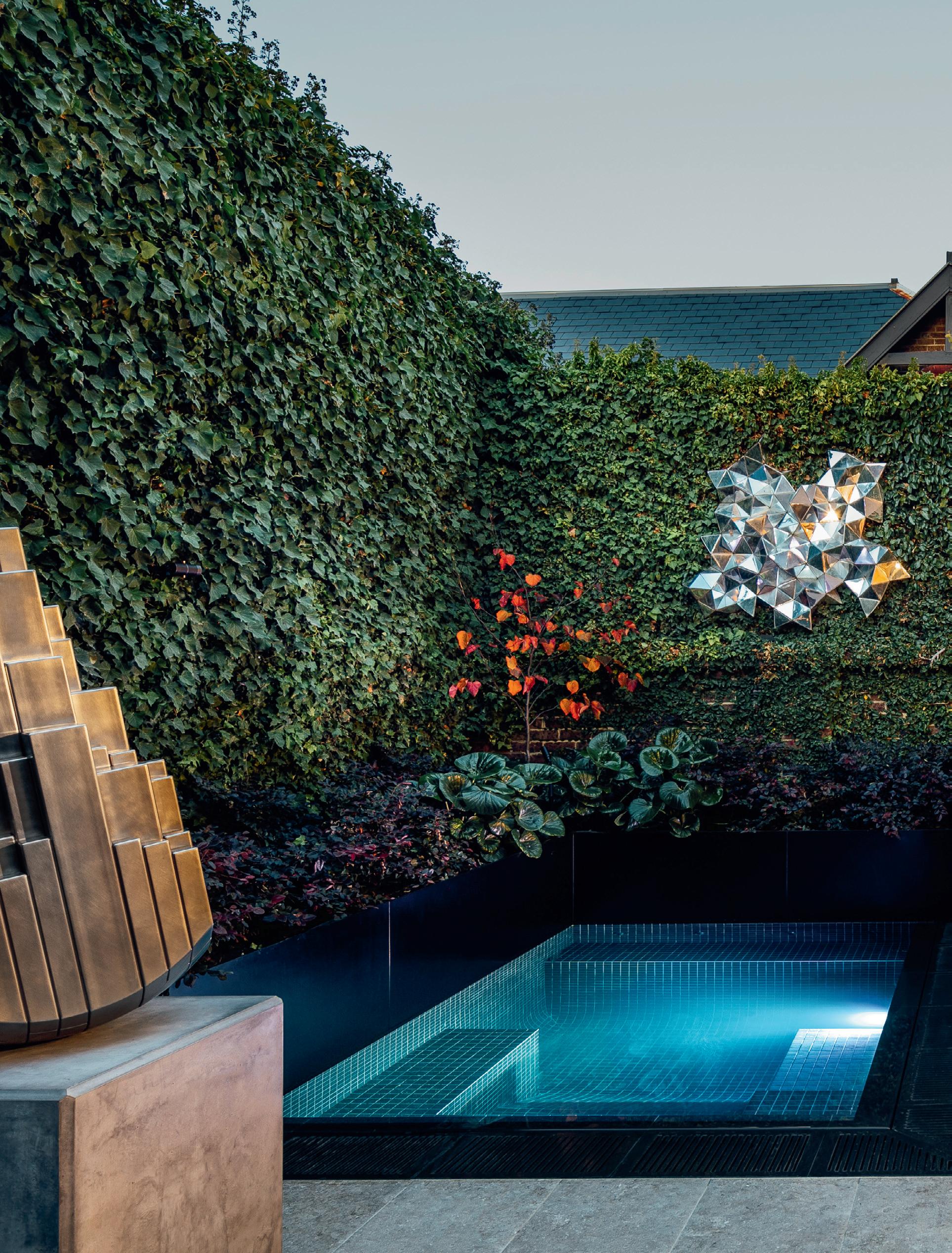
An Aloha pool is much more than a pool. It is the embodiment of craftsmanship, quality and luxury. It has the ability to create precious memories, contribute to beautiful familial experiences, and provide a lifestyle that will be cherished for decades to come.
For over 55 years and spanning three generations, we have learned and refined our skills. Drawing on that depth of knowledge and expertise allows us to craft your design into life. And the experience of standing before your completed Aloha pool for the first time, seeing your dream perfectly realised, is truly mesmerising.
As part of a significant renovation of the existing heritage listed home, the spa and courtyard space was remodelled to reflect a contemporary architectural style. The result is nothing short of spectacular, with the spa providing a reflective surface to enhance the surrounding sculptures.
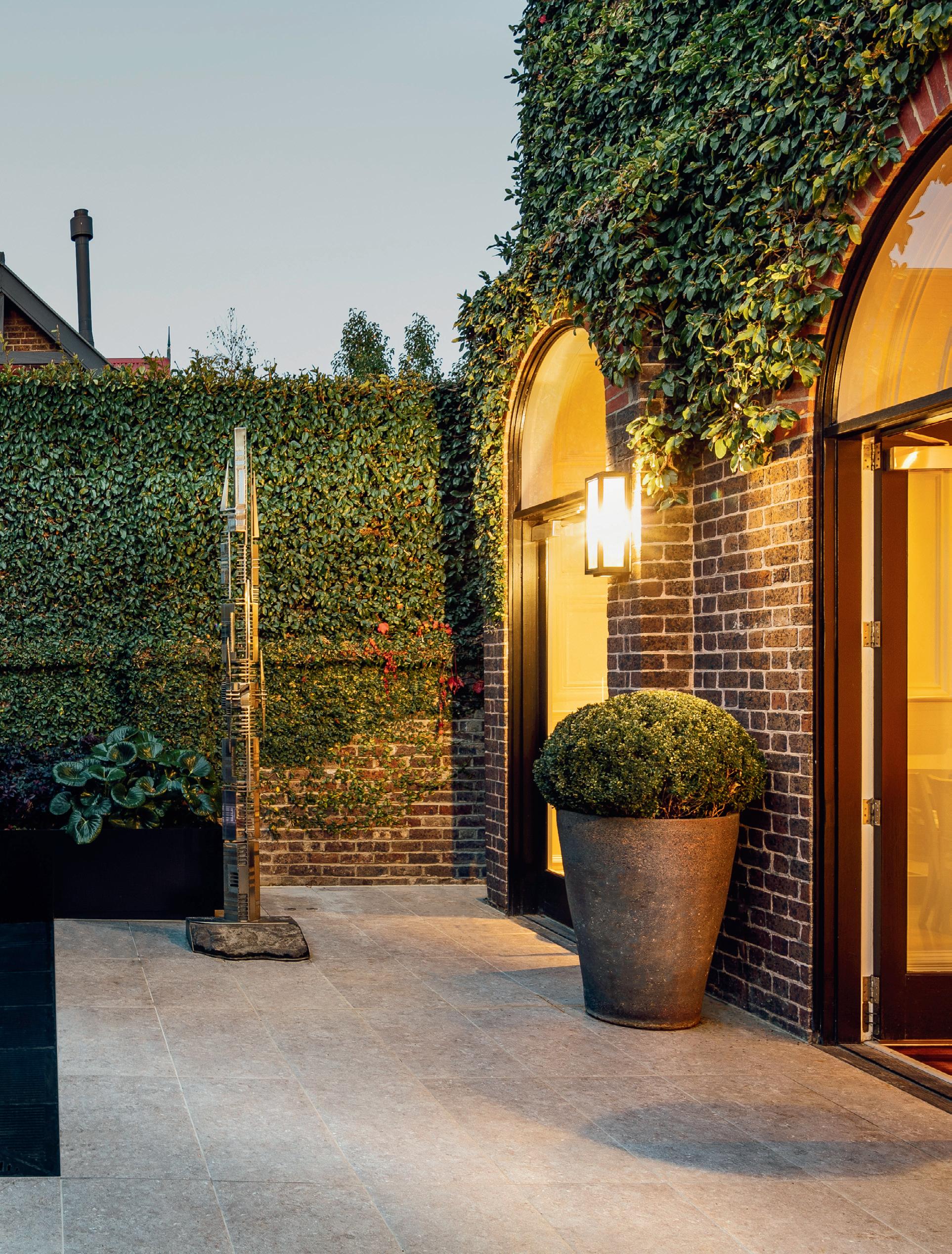
P: 03 9775 0033
E: ENQUIRIES@ALOHAPOOLS.COM.AU
W: WWW.ALOHAPOOLS.COM.AU
Pool & Spa is produced for SPASA Australia by WestwickFarrow Media.
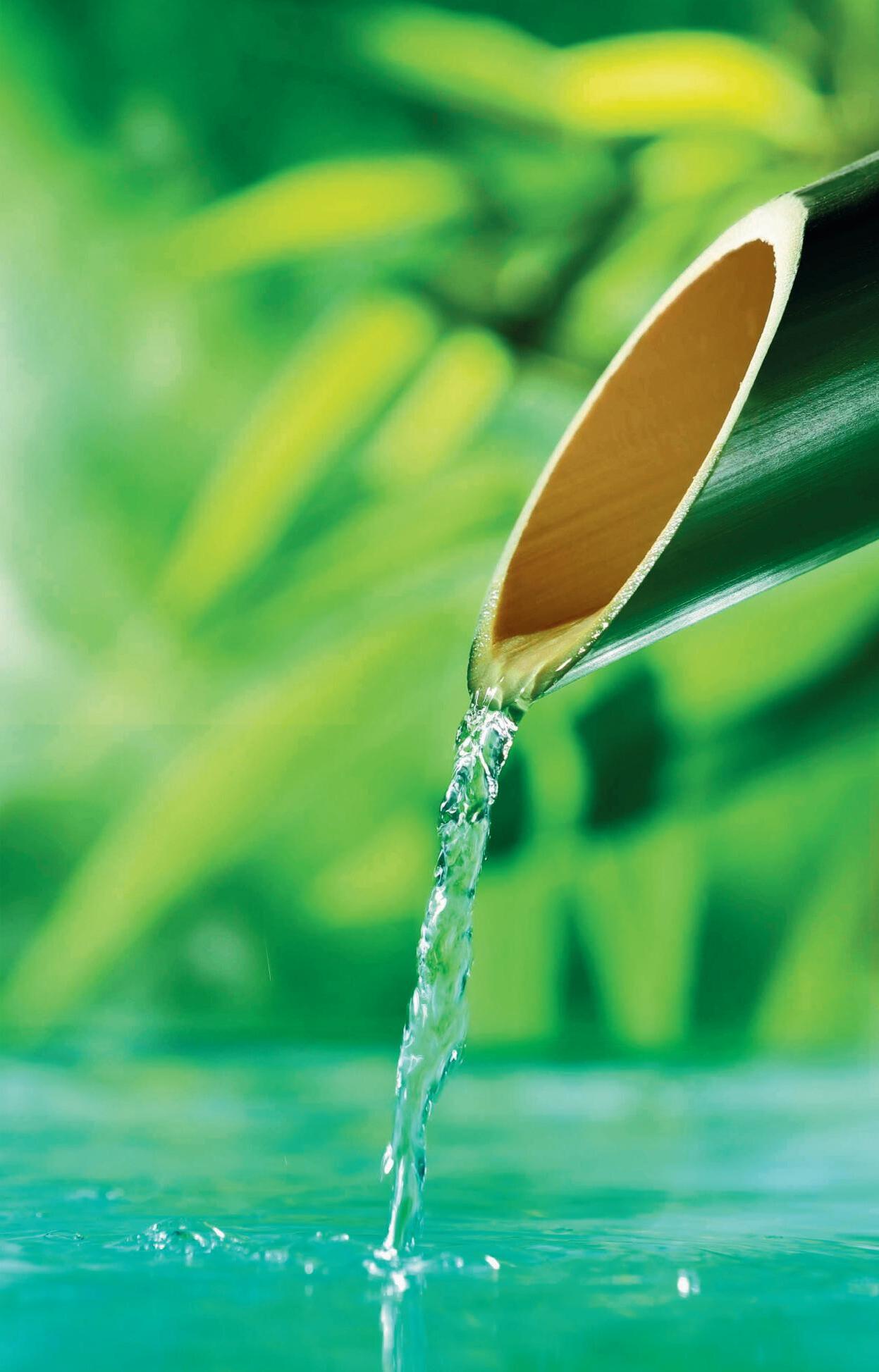
Westwick-Farrow Media
A.B.N. 22 152 305 336 www.wfmedia.com.au
Head Office: Unit 7, 6–8 Byfield Street, (Locked Bag 2226) North Ryde BC NSW 1670, AUSTRALIA
Ph: +61 2 9168 2500
Editor: Dannielle Furness dfurness@wfmedia.com.au
Publishing Director: Geoff Hird
Art Director/Production Manager: Julie Wright
Art/Production: Linda Klobusiak, Marija Tutkovska
Distribution: Dianna Alberry circulation@wfmedia.com.au
Advertising Sales: David Stennett
Ph: 0404 725 554 david@spasa.com.au
All material published in this magazine is published in good faith and every care is taken to accurately relay information provided to us. Readers are advised by the publishers to ensure that all necessary safety devices and precautions are installed and safe working procedures adopted before the use of any equipment found or purchased through the information we provide. Further, all performance criteria was provided by the representative company concerned and any dispute should be referred to them. Information indicating that products are made in Australia or New Zealand is supplied by the source company. Westwick-Farrow Pty Ltd does not quantify the amount of local content or the accuracy of the statement made by the source.
PP 100008830 • ISSN 2200-2464
for current and future pool and spa owners

